Impact of Organizational Culture on Performance
VerifiedAdded on 2020/05/28
|17
|3458
|113
AI Summary
The assignment delves into the influence of organizational culture on employee performance. It examines various aspects of organizational culture, including shared leadership, vertical leadership, integrity, and group-oriented organizational culture. The analysis draws upon empirical research and theoretical frameworks to understand how these cultural elements impact employee motivation, innovation, and overall productivity.
Contribute Materials
Your contribution can guide someone’s learning journey. Share your
documents today.
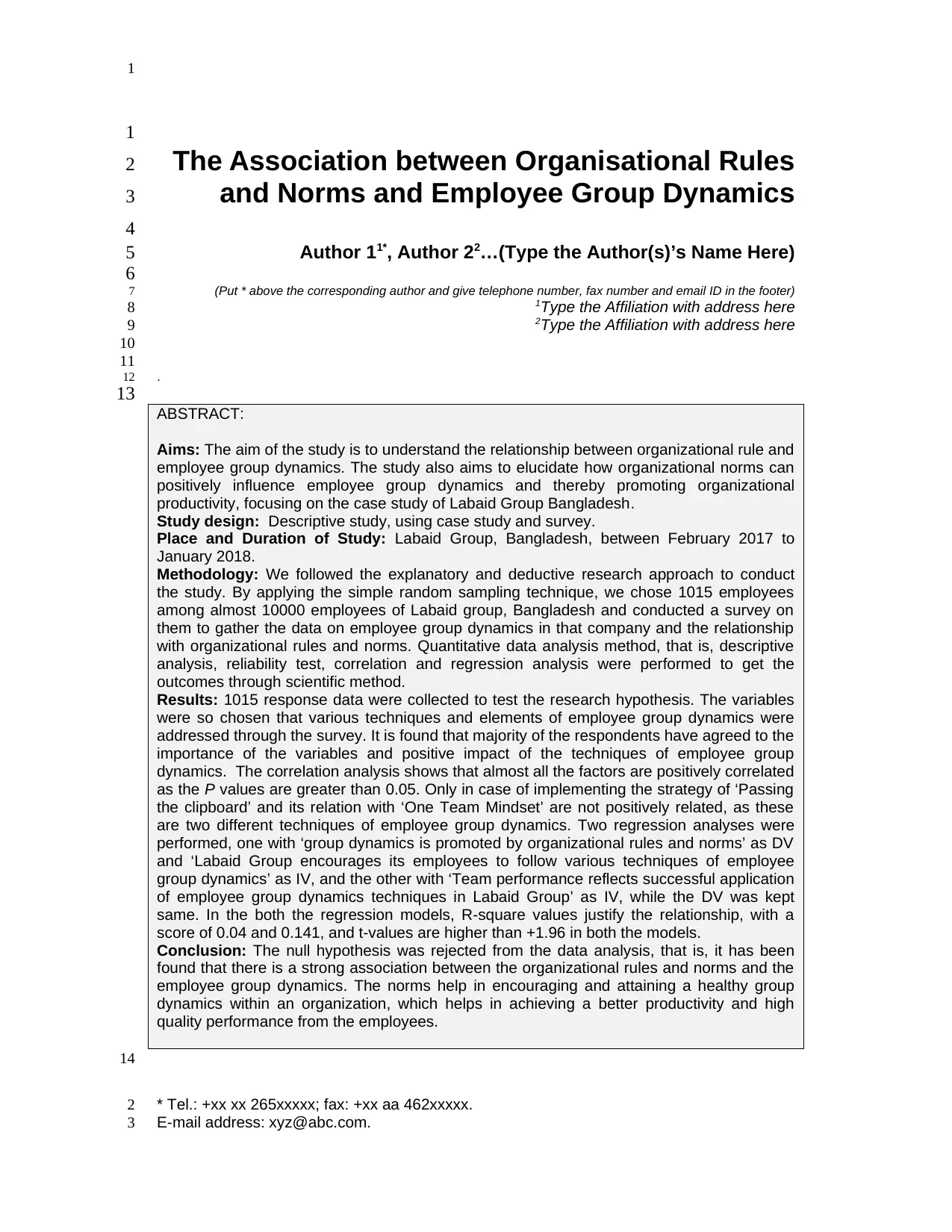
The Association between Organisational Rules
and Norms and Employee Group Dynamics
Author 11*, Author 22…(Type the Author(s)’s Name Here)
(Put * above the corresponding author and give telephone number, fax number and email ID in the footer)
1Type the Affiliation with address here
2Type the Affiliation with address here
.
ABSTRACT:
Aims: The aim of the study is to understand the relationship between organizational rule and
employee group dynamics. The study also aims to elucidate how organizational norms can
positively influence employee group dynamics and thereby promoting organizational
productivity, focusing on the case study of Labaid Group Bangladesh.
Study design: Descriptive study, using case study and survey.
Place and Duration of Study: Labaid Group, Bangladesh, between February 2017 to
January 2018.
Methodology: We followed the explanatory and deductive research approach to conduct
the study. By applying the simple random sampling technique, we chose 1015 employees
among almost 10000 employees of Labaid group, Bangladesh and conducted a survey on
them to gather the data on employee group dynamics in that company and the relationship
with organizational rules and norms. Quantitative data analysis method, that is, descriptive
analysis, reliability test, correlation and regression analysis were performed to get the
outcomes through scientific method.
Results: 1015 response data were collected to test the research hypothesis. The variables
were so chosen that various techniques and elements of employee group dynamics were
addressed through the survey. It is found that majority of the respondents have agreed to the
importance of the variables and positive impact of the techniques of employee group
dynamics. The correlation analysis shows that almost all the factors are positively correlated
as the P values are greater than 0.05. Only in case of implementing the strategy of ‘Passing
the clipboard’ and its relation with ‘One Team Mindset’ are not positively related, as these
are two different techniques of employee group dynamics. Two regression analyses were
performed, one with ‘group dynamics is promoted by organizational rules and norms’ as DV
and ‘Labaid Group encourages its employees to follow various techniques of employee
group dynamics’ as IV, and the other with ‘Team performance reflects successful application
of employee group dynamics techniques in Labaid Group’ as IV, while the DV was kept
same. In the both the regression models, R-square values justify the relationship, with a
score of 0.04 and 0.141, and t-values are higher than +1.96 in both the models.
Conclusion: The null hypothesis was rejected from the data analysis, that is, it has been
found that there is a strong association between the organizational rules and norms and the
employee group dynamics. The norms help in encouraging and attaining a healthy group
dynamics within an organization, which helps in achieving a better productivity and high
quality performance from the employees.
* Tel.: +xx xx 265xxxxx; fax: +xx aa 462xxxxx.
E-mail address: xyz@abc.com.
1
1
2
3
4
5
6
7
8
9
10
11
12
13
14
2
3
and Norms and Employee Group Dynamics
Author 11*, Author 22…(Type the Author(s)’s Name Here)
(Put * above the corresponding author and give telephone number, fax number and email ID in the footer)
1Type the Affiliation with address here
2Type the Affiliation with address here
.
ABSTRACT:
Aims: The aim of the study is to understand the relationship between organizational rule and
employee group dynamics. The study also aims to elucidate how organizational norms can
positively influence employee group dynamics and thereby promoting organizational
productivity, focusing on the case study of Labaid Group Bangladesh.
Study design: Descriptive study, using case study and survey.
Place and Duration of Study: Labaid Group, Bangladesh, between February 2017 to
January 2018.
Methodology: We followed the explanatory and deductive research approach to conduct
the study. By applying the simple random sampling technique, we chose 1015 employees
among almost 10000 employees of Labaid group, Bangladesh and conducted a survey on
them to gather the data on employee group dynamics in that company and the relationship
with organizational rules and norms. Quantitative data analysis method, that is, descriptive
analysis, reliability test, correlation and regression analysis were performed to get the
outcomes through scientific method.
Results: 1015 response data were collected to test the research hypothesis. The variables
were so chosen that various techniques and elements of employee group dynamics were
addressed through the survey. It is found that majority of the respondents have agreed to the
importance of the variables and positive impact of the techniques of employee group
dynamics. The correlation analysis shows that almost all the factors are positively correlated
as the P values are greater than 0.05. Only in case of implementing the strategy of ‘Passing
the clipboard’ and its relation with ‘One Team Mindset’ are not positively related, as these
are two different techniques of employee group dynamics. Two regression analyses were
performed, one with ‘group dynamics is promoted by organizational rules and norms’ as DV
and ‘Labaid Group encourages its employees to follow various techniques of employee
group dynamics’ as IV, and the other with ‘Team performance reflects successful application
of employee group dynamics techniques in Labaid Group’ as IV, while the DV was kept
same. In the both the regression models, R-square values justify the relationship, with a
score of 0.04 and 0.141, and t-values are higher than +1.96 in both the models.
Conclusion: The null hypothesis was rejected from the data analysis, that is, it has been
found that there is a strong association between the organizational rules and norms and the
employee group dynamics. The norms help in encouraging and attaining a healthy group
dynamics within an organization, which helps in achieving a better productivity and high
quality performance from the employees.
* Tel.: +xx xx 265xxxxx; fax: +xx aa 462xxxxx.
E-mail address: xyz@abc.com.
1
1
2
3
4
5
6
7
8
9
10
11
12
13
14
2
3
Secure Best Marks with AI Grader
Need help grading? Try our AI Grader for instant feedback on your assignments.
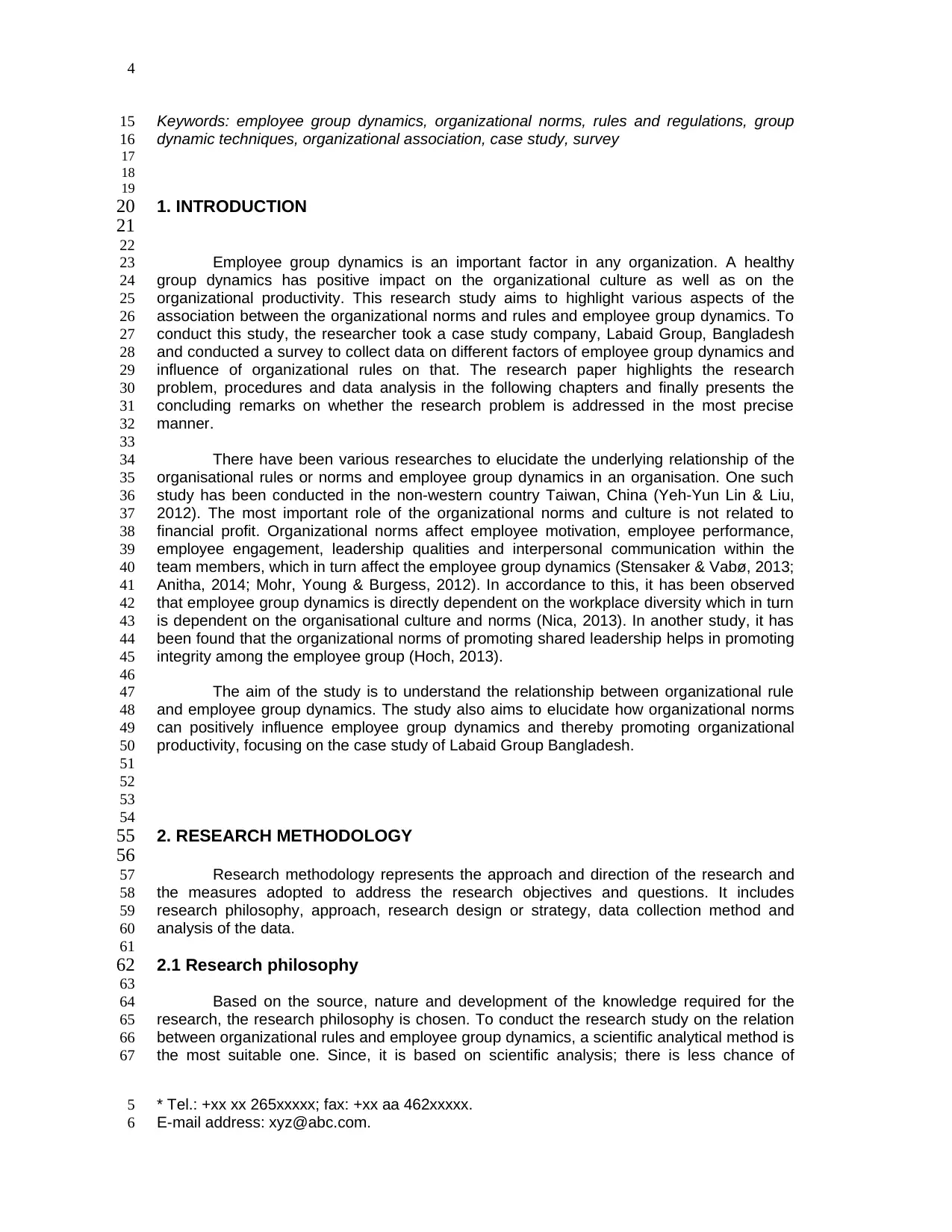
Keywords: employee group dynamics, organizational norms, rules and regulations, group
dynamic techniques, organizational association, case study, survey
1. INTRODUCTION
Employee group dynamics is an important factor in any organization. A healthy
group dynamics has positive impact on the organizational culture as well as on the
organizational productivity. This research study aims to highlight various aspects of the
association between the organizational norms and rules and employee group dynamics. To
conduct this study, the researcher took a case study company, Labaid Group, Bangladesh
and conducted a survey to collect data on different factors of employee group dynamics and
influence of organizational rules on that. The research paper highlights the research
problem, procedures and data analysis in the following chapters and finally presents the
concluding remarks on whether the research problem is addressed in the most precise
manner.
There have been various researches to elucidate the underlying relationship of the
organisational rules or norms and employee group dynamics in an organisation. One such
study has been conducted in the non-western country Taiwan, China (Yeh-Yun Lin & Liu,
2012). The most important role of the organizational norms and culture is not related to
financial profit. Organizational norms affect employee motivation, employee performance,
employee engagement, leadership qualities and interpersonal communication within the
team members, which in turn affect the employee group dynamics (Stensaker & Vabø, 2013;
Anitha, 2014; Mohr, Young & Burgess, 2012). In accordance to this, it has been observed
that employee group dynamics is directly dependent on the workplace diversity which in turn
is dependent on the organisational culture and norms (Nica, 2013). In another study, it has
been found that the organizational norms of promoting shared leadership helps in promoting
integrity among the employee group (Hoch, 2013).
The aim of the study is to understand the relationship between organizational rule
and employee group dynamics. The study also aims to elucidate how organizational norms
can positively influence employee group dynamics and thereby promoting organizational
productivity, focusing on the case study of Labaid Group Bangladesh.
2. RESEARCH METHODOLOGY
Research methodology represents the approach and direction of the research and
the measures adopted to address the research objectives and questions. It includes
research philosophy, approach, research design or strategy, data collection method and
analysis of the data.
2.1 Research philosophy
Based on the source, nature and development of the knowledge required for the
research, the research philosophy is chosen. To conduct the research study on the relation
between organizational rules and employee group dynamics, a scientific analytical method is
the most suitable one. Since, it is based on scientific analysis; there is less chance of
* Tel.: +xx xx 265xxxxx; fax: +xx aa 462xxxxx.
E-mail address: xyz@abc.com.
4
15
16
17
18
19
20
21
22
23
24
25
26
27
28
29
30
31
32
33
34
35
36
37
38
39
40
41
42
43
44
45
46
47
48
49
50
51
52
53
54
55
56
57
58
59
60
61
62
63
64
65
66
67
5
6
dynamic techniques, organizational association, case study, survey
1. INTRODUCTION
Employee group dynamics is an important factor in any organization. A healthy
group dynamics has positive impact on the organizational culture as well as on the
organizational productivity. This research study aims to highlight various aspects of the
association between the organizational norms and rules and employee group dynamics. To
conduct this study, the researcher took a case study company, Labaid Group, Bangladesh
and conducted a survey to collect data on different factors of employee group dynamics and
influence of organizational rules on that. The research paper highlights the research
problem, procedures and data analysis in the following chapters and finally presents the
concluding remarks on whether the research problem is addressed in the most precise
manner.
There have been various researches to elucidate the underlying relationship of the
organisational rules or norms and employee group dynamics in an organisation. One such
study has been conducted in the non-western country Taiwan, China (Yeh-Yun Lin & Liu,
2012). The most important role of the organizational norms and culture is not related to
financial profit. Organizational norms affect employee motivation, employee performance,
employee engagement, leadership qualities and interpersonal communication within the
team members, which in turn affect the employee group dynamics (Stensaker & Vabø, 2013;
Anitha, 2014; Mohr, Young & Burgess, 2012). In accordance to this, it has been observed
that employee group dynamics is directly dependent on the workplace diversity which in turn
is dependent on the organisational culture and norms (Nica, 2013). In another study, it has
been found that the organizational norms of promoting shared leadership helps in promoting
integrity among the employee group (Hoch, 2013).
The aim of the study is to understand the relationship between organizational rule
and employee group dynamics. The study also aims to elucidate how organizational norms
can positively influence employee group dynamics and thereby promoting organizational
productivity, focusing on the case study of Labaid Group Bangladesh.
2. RESEARCH METHODOLOGY
Research methodology represents the approach and direction of the research and
the measures adopted to address the research objectives and questions. It includes
research philosophy, approach, research design or strategy, data collection method and
analysis of the data.
2.1 Research philosophy
Based on the source, nature and development of the knowledge required for the
research, the research philosophy is chosen. To conduct the research study on the relation
between organizational rules and employee group dynamics, a scientific analytical method is
the most suitable one. Since, it is based on scientific analysis; there is less chance of
* Tel.: +xx xx 265xxxxx; fax: +xx aa 462xxxxx.
E-mail address: xyz@abc.com.
4
15
16
17
18
19
20
21
22
23
24
25
26
27
28
29
30
31
32
33
34
35
36
37
38
39
40
41
42
43
44
45
46
47
48
49
50
51
52
53
54
55
56
57
58
59
60
61
62
63
64
65
66
67
5
6
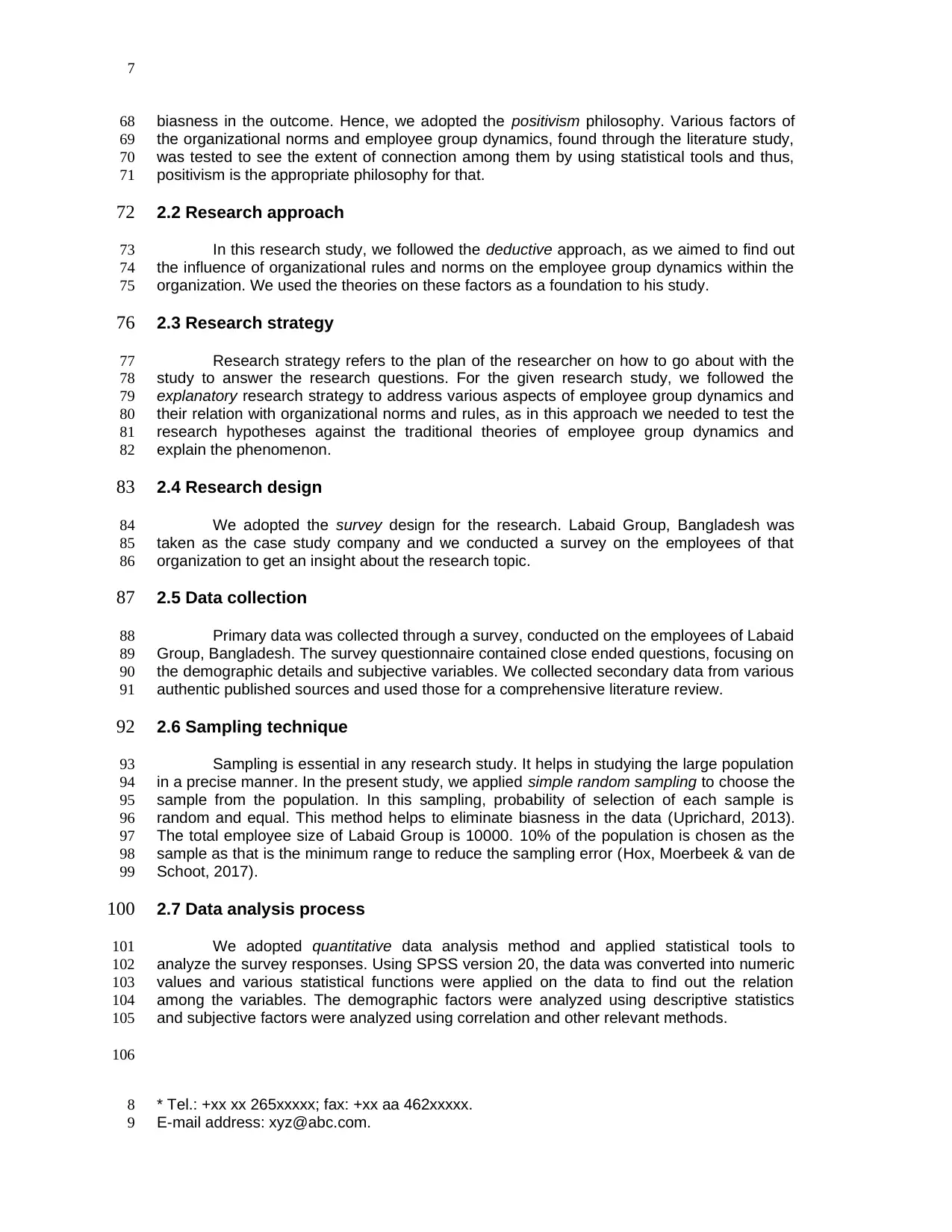
biasness in the outcome. Hence, we adopted the positivism philosophy. Various factors of
the organizational norms and employee group dynamics, found through the literature study,
was tested to see the extent of connection among them by using statistical tools and thus,
positivism is the appropriate philosophy for that.
2.2 Research approach
In this research study, we followed the deductive approach, as we aimed to find out
the influence of organizational rules and norms on the employee group dynamics within the
organization. We used the theories on these factors as a foundation to his study.
2.3 Research strategy
Research strategy refers to the plan of the researcher on how to go about with the
study to answer the research questions. For the given research study, we followed the
explanatory research strategy to address various aspects of employee group dynamics and
their relation with organizational norms and rules, as in this approach we needed to test the
research hypotheses against the traditional theories of employee group dynamics and
explain the phenomenon.
2.4 Research design
We adopted the survey design for the research. Labaid Group, Bangladesh was
taken as the case study company and we conducted a survey on the employees of that
organization to get an insight about the research topic.
2.5 Data collection
Primary data was collected through a survey, conducted on the employees of Labaid
Group, Bangladesh. The survey questionnaire contained close ended questions, focusing on
the demographic details and subjective variables. We collected secondary data from various
authentic published sources and used those for a comprehensive literature review.
2.6 Sampling technique
Sampling is essential in any research study. It helps in studying the large population
in a precise manner. In the present study, we applied simple random sampling to choose the
sample from the population. In this sampling, probability of selection of each sample is
random and equal. This method helps to eliminate biasness in the data (Uprichard, 2013).
The total employee size of Labaid Group is 10000. 10% of the population is chosen as the
sample as that is the minimum range to reduce the sampling error (Hox, Moerbeek & van de
Schoot, 2017).
2.7 Data analysis process
We adopted quantitative data analysis method and applied statistical tools to
analyze the survey responses. Using SPSS version 20, the data was converted into numeric
values and various statistical functions were applied on the data to find out the relation
among the variables. The demographic factors were analyzed using descriptive statistics
and subjective factors were analyzed using correlation and other relevant methods.
* Tel.: +xx xx 265xxxxx; fax: +xx aa 462xxxxx.
E-mail address: xyz@abc.com.
7
68
69
70
71
72
73
74
75
76
77
78
79
80
81
82
83
84
85
86
87
88
89
90
91
92
93
94
95
96
97
98
99
100
101
102
103
104
105
106
8
9
the organizational norms and employee group dynamics, found through the literature study,
was tested to see the extent of connection among them by using statistical tools and thus,
positivism is the appropriate philosophy for that.
2.2 Research approach
In this research study, we followed the deductive approach, as we aimed to find out
the influence of organizational rules and norms on the employee group dynamics within the
organization. We used the theories on these factors as a foundation to his study.
2.3 Research strategy
Research strategy refers to the plan of the researcher on how to go about with the
study to answer the research questions. For the given research study, we followed the
explanatory research strategy to address various aspects of employee group dynamics and
their relation with organizational norms and rules, as in this approach we needed to test the
research hypotheses against the traditional theories of employee group dynamics and
explain the phenomenon.
2.4 Research design
We adopted the survey design for the research. Labaid Group, Bangladesh was
taken as the case study company and we conducted a survey on the employees of that
organization to get an insight about the research topic.
2.5 Data collection
Primary data was collected through a survey, conducted on the employees of Labaid
Group, Bangladesh. The survey questionnaire contained close ended questions, focusing on
the demographic details and subjective variables. We collected secondary data from various
authentic published sources and used those for a comprehensive literature review.
2.6 Sampling technique
Sampling is essential in any research study. It helps in studying the large population
in a precise manner. In the present study, we applied simple random sampling to choose the
sample from the population. In this sampling, probability of selection of each sample is
random and equal. This method helps to eliminate biasness in the data (Uprichard, 2013).
The total employee size of Labaid Group is 10000. 10% of the population is chosen as the
sample as that is the minimum range to reduce the sampling error (Hox, Moerbeek & van de
Schoot, 2017).
2.7 Data analysis process
We adopted quantitative data analysis method and applied statistical tools to
analyze the survey responses. Using SPSS version 20, the data was converted into numeric
values and various statistical functions were applied on the data to find out the relation
among the variables. The demographic factors were analyzed using descriptive statistics
and subjective factors were analyzed using correlation and other relevant methods.
* Tel.: +xx xx 265xxxxx; fax: +xx aa 462xxxxx.
E-mail address: xyz@abc.com.
7
68
69
70
71
72
73
74
75
76
77
78
79
80
81
82
83
84
85
86
87
88
89
90
91
92
93
94
95
96
97
98
99
100
101
102
103
104
105
106
8
9
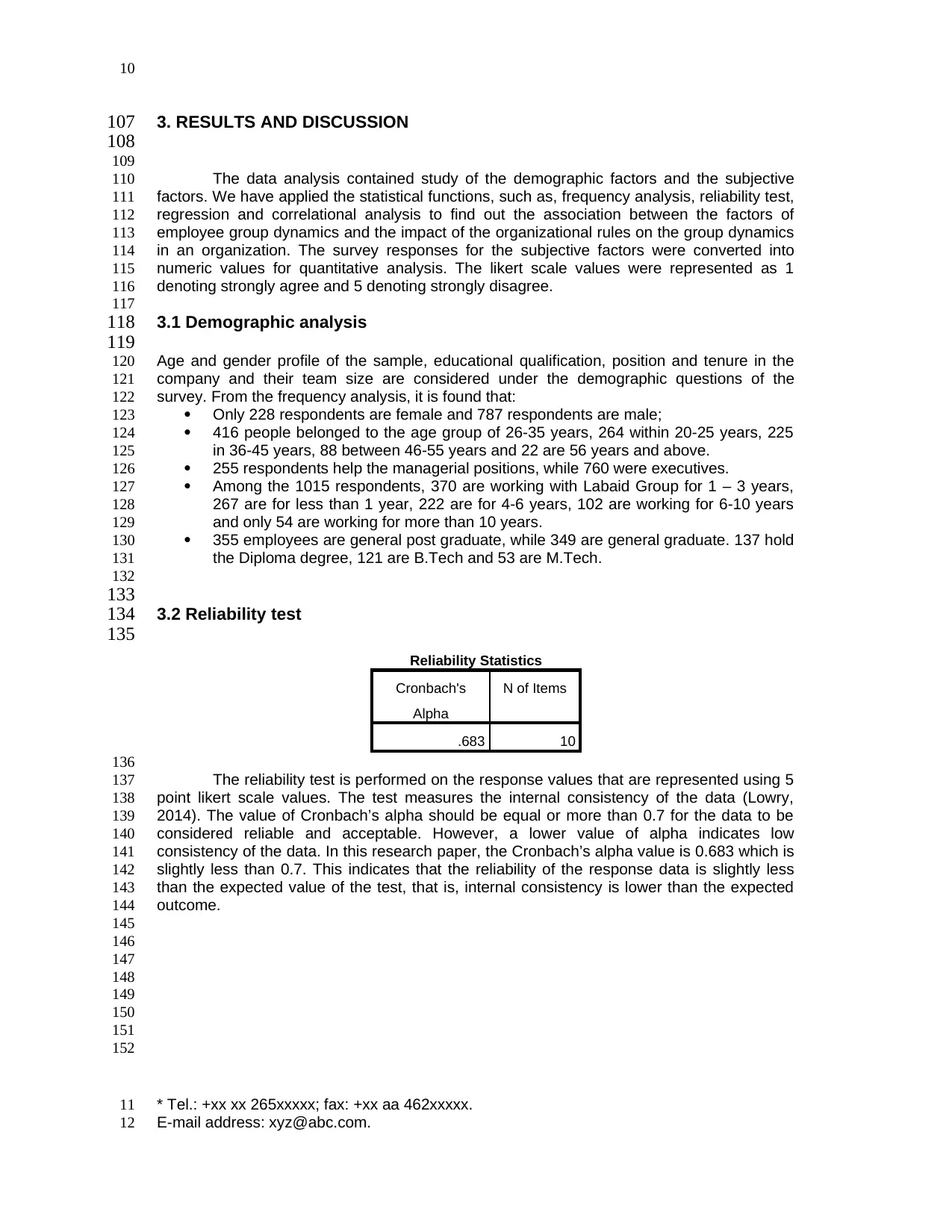
3. RESULTS AND DISCUSSION
The data analysis contained study of the demographic factors and the subjective
factors. We have applied the statistical functions, such as, frequency analysis, reliability test,
regression and correlational analysis to find out the association between the factors of
employee group dynamics and the impact of the organizational rules on the group dynamics
in an organization. The survey responses for the subjective factors were converted into
numeric values for quantitative analysis. The likert scale values were represented as 1
denoting strongly agree and 5 denoting strongly disagree.
3.1 Demographic analysis
Age and gender profile of the sample, educational qualification, position and tenure in the
company and their team size are considered under the demographic questions of the
survey. From the frequency analysis, it is found that:
Only 228 respondents are female and 787 respondents are male;
416 people belonged to the age group of 26-35 years, 264 within 20-25 years, 225
in 36-45 years, 88 between 46-55 years and 22 are 56 years and above.
255 respondents help the managerial positions, while 760 were executives.
Among the 1015 respondents, 370 are working with Labaid Group for 1 – 3 years,
267 are for less than 1 year, 222 are for 4-6 years, 102 are working for 6-10 years
and only 54 are working for more than 10 years.
355 employees are general post graduate, while 349 are general graduate. 137 hold
the Diploma degree, 121 are B.Tech and 53 are M.Tech.
3.2 Reliability test
Reliability Statistics
Cronbach's
Alpha
N of Items
.683 10
The reliability test is performed on the response values that are represented using 5
point likert scale values. The test measures the internal consistency of the data (Lowry,
2014). The value of Cronbach’s alpha should be equal or more than 0.7 for the data to be
considered reliable and acceptable. However, a lower value of alpha indicates low
consistency of the data. In this research paper, the Cronbach’s alpha value is 0.683 which is
slightly less than 0.7. This indicates that the reliability of the response data is slightly less
than the expected value of the test, that is, internal consistency is lower than the expected
outcome.
* Tel.: +xx xx 265xxxxx; fax: +xx aa 462xxxxx.
E-mail address: xyz@abc.com.
10
107
108
109
110
111
112
113
114
115
116
117
118
119
120
121
122
123
124
125
126
127
128
129
130
131
132
133
134
135
136
137
138
139
140
141
142
143
144
145
146
147
148
149
150
151
152
11
12
The data analysis contained study of the demographic factors and the subjective
factors. We have applied the statistical functions, such as, frequency analysis, reliability test,
regression and correlational analysis to find out the association between the factors of
employee group dynamics and the impact of the organizational rules on the group dynamics
in an organization. The survey responses for the subjective factors were converted into
numeric values for quantitative analysis. The likert scale values were represented as 1
denoting strongly agree and 5 denoting strongly disagree.
3.1 Demographic analysis
Age and gender profile of the sample, educational qualification, position and tenure in the
company and their team size are considered under the demographic questions of the
survey. From the frequency analysis, it is found that:
Only 228 respondents are female and 787 respondents are male;
416 people belonged to the age group of 26-35 years, 264 within 20-25 years, 225
in 36-45 years, 88 between 46-55 years and 22 are 56 years and above.
255 respondents help the managerial positions, while 760 were executives.
Among the 1015 respondents, 370 are working with Labaid Group for 1 – 3 years,
267 are for less than 1 year, 222 are for 4-6 years, 102 are working for 6-10 years
and only 54 are working for more than 10 years.
355 employees are general post graduate, while 349 are general graduate. 137 hold
the Diploma degree, 121 are B.Tech and 53 are M.Tech.
3.2 Reliability test
Reliability Statistics
Cronbach's
Alpha
N of Items
.683 10
The reliability test is performed on the response values that are represented using 5
point likert scale values. The test measures the internal consistency of the data (Lowry,
2014). The value of Cronbach’s alpha should be equal or more than 0.7 for the data to be
considered reliable and acceptable. However, a lower value of alpha indicates low
consistency of the data. In this research paper, the Cronbach’s alpha value is 0.683 which is
slightly less than 0.7. This indicates that the reliability of the response data is slightly less
than the expected value of the test, that is, internal consistency is lower than the expected
outcome.
* Tel.: +xx xx 265xxxxx; fax: +xx aa 462xxxxx.
E-mail address: xyz@abc.com.
10
107
108
109
110
111
112
113
114
115
116
117
118
119
120
121
122
123
124
125
126
127
128
129
130
131
132
133
134
135
136
137
138
139
140
141
142
143
144
145
146
147
148
149
150
151
152
11
12
Secure Best Marks with AI Grader
Need help grading? Try our AI Grader for instant feedback on your assignments.
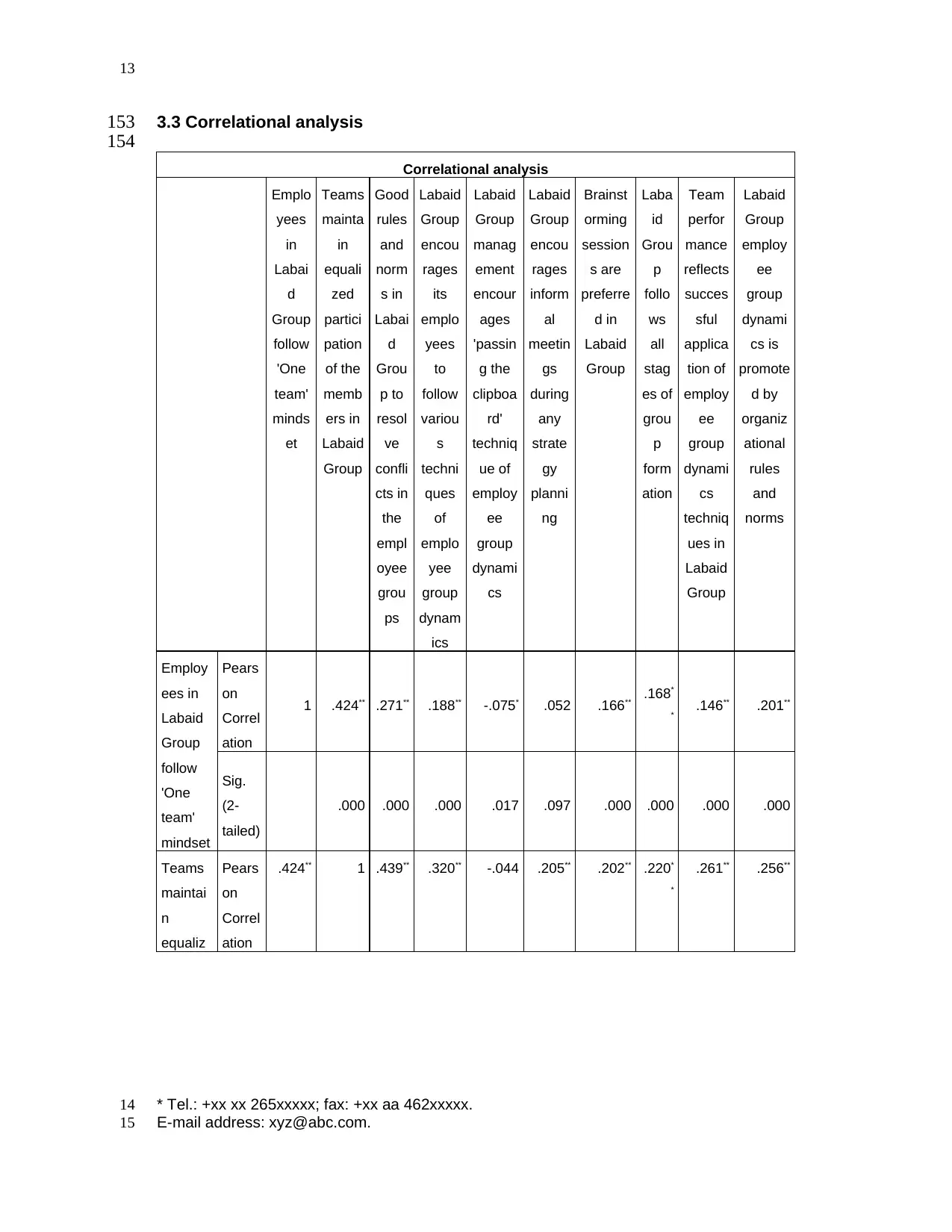
3.3 Correlational analysis
Correlational analysis
Emplo
yees
in
Labai
d
Group
follow
'One
team'
minds
et
Teams
mainta
in
equali
zed
partici
pation
of the
memb
ers in
Labaid
Group
Good
rules
and
norm
s in
Labai
d
Grou
p to
resol
ve
confli
cts in
the
empl
oyee
grou
ps
Labaid
Group
encou
rages
its
emplo
yees
to
follow
variou
s
techni
ques
of
emplo
yee
group
dynam
ics
Labaid
Group
manag
ement
encour
ages
'passin
g the
clipboa
rd'
techniq
ue of
employ
ee
group
dynami
cs
Labaid
Group
encou
rages
inform
al
meetin
gs
during
any
strate
gy
planni
ng
Brainst
orming
session
s are
preferre
d in
Labaid
Group
Laba
id
Grou
p
follo
ws
all
stag
es of
grou
p
form
ation
Team
perfor
mance
reflects
succes
sful
applica
tion of
employ
ee
group
dynami
cs
techniq
ues in
Labaid
Group
Labaid
Group
employ
ee
group
dynami
cs is
promote
d by
organiz
ational
rules
and
norms
Employ
ees in
Labaid
Group
follow
'One
team'
mindset
Pears
on
Correl
ation
1 .424** .271** .188** -.075* .052 .166** .168*
* .146** .201**
Sig.
(2-
tailed)
.000 .000 .000 .017 .097 .000 .000 .000 .000
Teams
maintai
n
equaliz
Pears
on
Correl
ation
.424** 1 .439** .320** -.044 .205** .202** .220*
*
.261** .256**
* Tel.: +xx xx 265xxxxx; fax: +xx aa 462xxxxx.
E-mail address: xyz@abc.com.
13
153
154
14
15
Correlational analysis
Emplo
yees
in
Labai
d
Group
follow
'One
team'
minds
et
Teams
mainta
in
equali
zed
partici
pation
of the
memb
ers in
Labaid
Group
Good
rules
and
norm
s in
Labai
d
Grou
p to
resol
ve
confli
cts in
the
empl
oyee
grou
ps
Labaid
Group
encou
rages
its
emplo
yees
to
follow
variou
s
techni
ques
of
emplo
yee
group
dynam
ics
Labaid
Group
manag
ement
encour
ages
'passin
g the
clipboa
rd'
techniq
ue of
employ
ee
group
dynami
cs
Labaid
Group
encou
rages
inform
al
meetin
gs
during
any
strate
gy
planni
ng
Brainst
orming
session
s are
preferre
d in
Labaid
Group
Laba
id
Grou
p
follo
ws
all
stag
es of
grou
p
form
ation
Team
perfor
mance
reflects
succes
sful
applica
tion of
employ
ee
group
dynami
cs
techniq
ues in
Labaid
Group
Labaid
Group
employ
ee
group
dynami
cs is
promote
d by
organiz
ational
rules
and
norms
Employ
ees in
Labaid
Group
follow
'One
team'
mindset
Pears
on
Correl
ation
1 .424** .271** .188** -.075* .052 .166** .168*
* .146** .201**
Sig.
(2-
tailed)
.000 .000 .000 .017 .097 .000 .000 .000 .000
Teams
maintai
n
equaliz
Pears
on
Correl
ation
.424** 1 .439** .320** -.044 .205** .202** .220*
*
.261** .256**
* Tel.: +xx xx 265xxxxx; fax: +xx aa 462xxxxx.
E-mail address: xyz@abc.com.
13
153
154
14
15
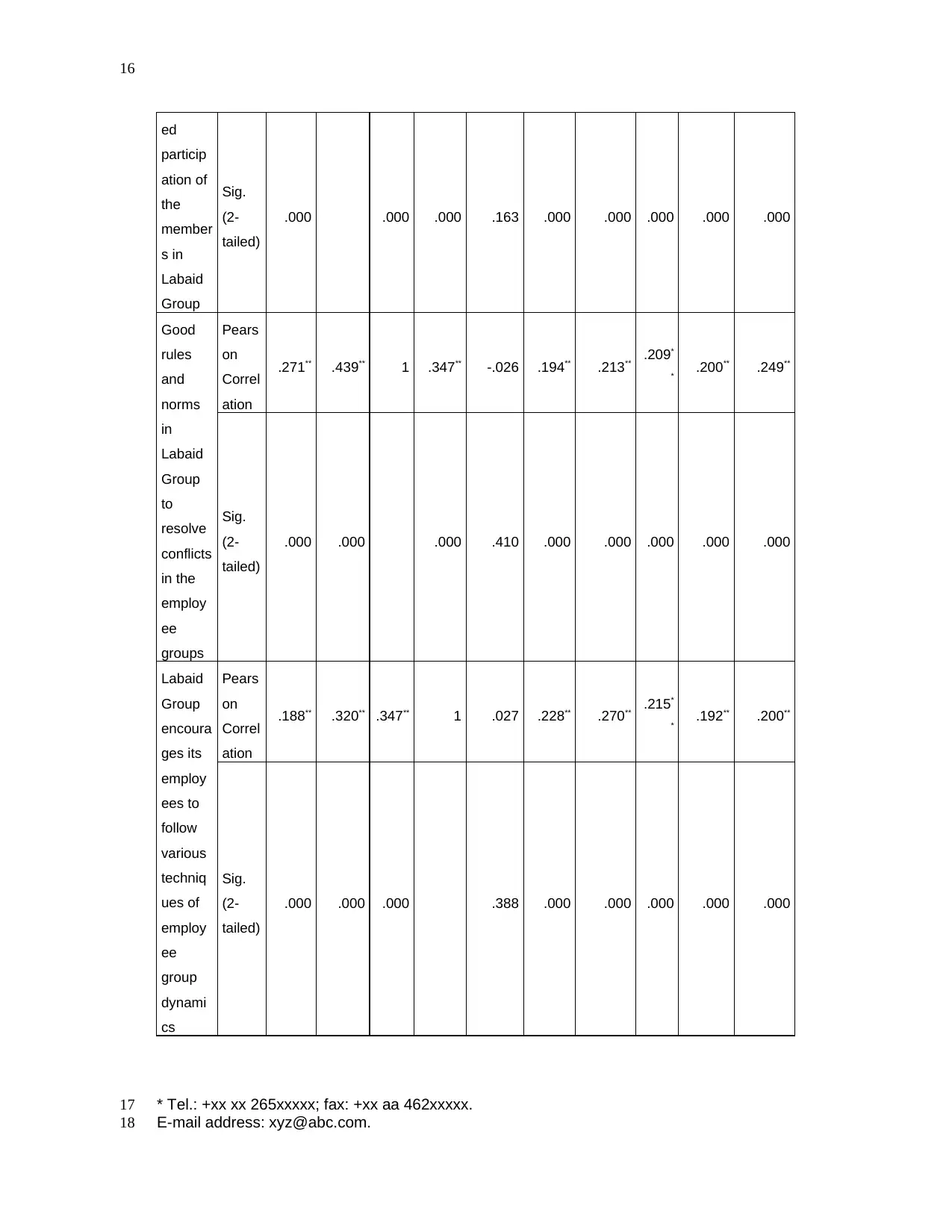
ed
particip
ation of
the
member
s in
Labaid
Group
Sig.
(2-
tailed)
.000 .000 .000 .163 .000 .000 .000 .000 .000
Good
rules
and
norms
in
Labaid
Group
to
resolve
conflicts
in the
employ
ee
groups
Pears
on
Correl
ation
.271** .439** 1 .347** -.026 .194** .213** .209*
* .200** .249**
Sig.
(2-
tailed)
.000 .000 .000 .410 .000 .000 .000 .000 .000
Labaid
Group
encoura
ges its
employ
ees to
follow
various
techniq
ues of
employ
ee
group
dynami
cs
Pears
on
Correl
ation
.188** .320** .347** 1 .027 .228** .270** .215*
* .192** .200**
Sig.
(2-
tailed)
.000 .000 .000 .388 .000 .000 .000 .000 .000
* Tel.: +xx xx 265xxxxx; fax: +xx aa 462xxxxx.
E-mail address: xyz@abc.com.
16
17
18
particip
ation of
the
member
s in
Labaid
Group
Sig.
(2-
tailed)
.000 .000 .000 .163 .000 .000 .000 .000 .000
Good
rules
and
norms
in
Labaid
Group
to
resolve
conflicts
in the
employ
ee
groups
Pears
on
Correl
ation
.271** .439** 1 .347** -.026 .194** .213** .209*
* .200** .249**
Sig.
(2-
tailed)
.000 .000 .000 .410 .000 .000 .000 .000 .000
Labaid
Group
encoura
ges its
employ
ees to
follow
various
techniq
ues of
employ
ee
group
dynami
cs
Pears
on
Correl
ation
.188** .320** .347** 1 .027 .228** .270** .215*
* .192** .200**
Sig.
(2-
tailed)
.000 .000 .000 .388 .000 .000 .000 .000 .000
* Tel.: +xx xx 265xxxxx; fax: +xx aa 462xxxxx.
E-mail address: xyz@abc.com.
16
17
18
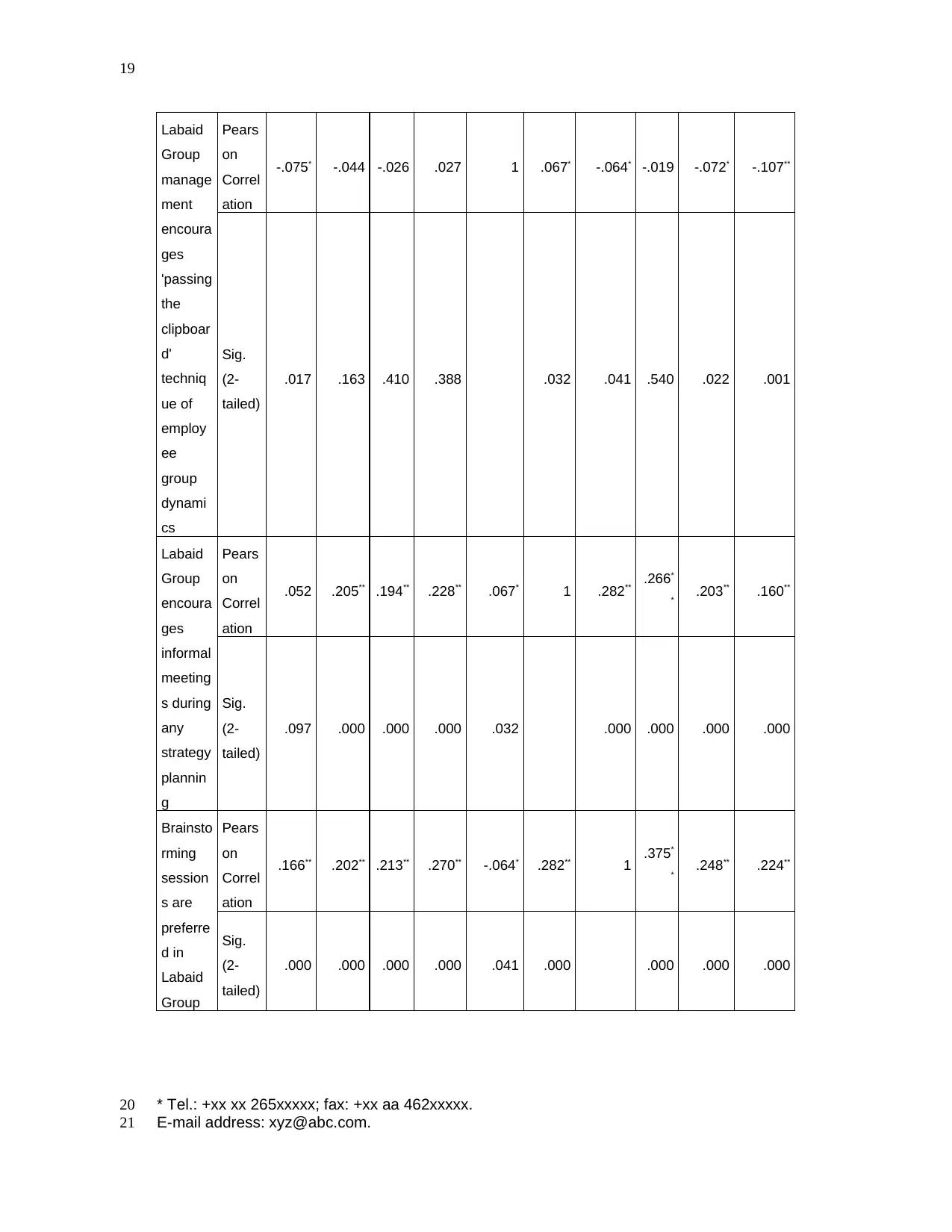
Labaid
Group
manage
ment
encoura
ges
'passing
the
clipboar
d'
techniq
ue of
employ
ee
group
dynami
cs
Pears
on
Correl
ation
-.075* -.044 -.026 .027 1 .067* -.064* -.019 -.072* -.107**
Sig.
(2-
tailed)
.017 .163 .410 .388 .032 .041 .540 .022 .001
Labaid
Group
encoura
ges
informal
meeting
s during
any
strategy
plannin
g
Pears
on
Correl
ation
.052 .205** .194** .228** .067* 1 .282** .266*
* .203** .160**
Sig.
(2-
tailed)
.097 .000 .000 .000 .032 .000 .000 .000 .000
Brainsto
rming
session
s are
preferre
d in
Labaid
Group
Pears
on
Correl
ation
.166** .202** .213** .270** -.064* .282** 1 .375*
* .248** .224**
Sig.
(2-
tailed)
.000 .000 .000 .000 .041 .000 .000 .000 .000
* Tel.: +xx xx 265xxxxx; fax: +xx aa 462xxxxx.
E-mail address: xyz@abc.com.
19
20
21
Group
manage
ment
encoura
ges
'passing
the
clipboar
d'
techniq
ue of
employ
ee
group
dynami
cs
Pears
on
Correl
ation
-.075* -.044 -.026 .027 1 .067* -.064* -.019 -.072* -.107**
Sig.
(2-
tailed)
.017 .163 .410 .388 .032 .041 .540 .022 .001
Labaid
Group
encoura
ges
informal
meeting
s during
any
strategy
plannin
g
Pears
on
Correl
ation
.052 .205** .194** .228** .067* 1 .282** .266*
* .203** .160**
Sig.
(2-
tailed)
.097 .000 .000 .000 .032 .000 .000 .000 .000
Brainsto
rming
session
s are
preferre
d in
Labaid
Group
Pears
on
Correl
ation
.166** .202** .213** .270** -.064* .282** 1 .375*
* .248** .224**
Sig.
(2-
tailed)
.000 .000 .000 .000 .041 .000 .000 .000 .000
* Tel.: +xx xx 265xxxxx; fax: +xx aa 462xxxxx.
E-mail address: xyz@abc.com.
19
20
21
Paraphrase This Document
Need a fresh take? Get an instant paraphrase of this document with our AI Paraphraser
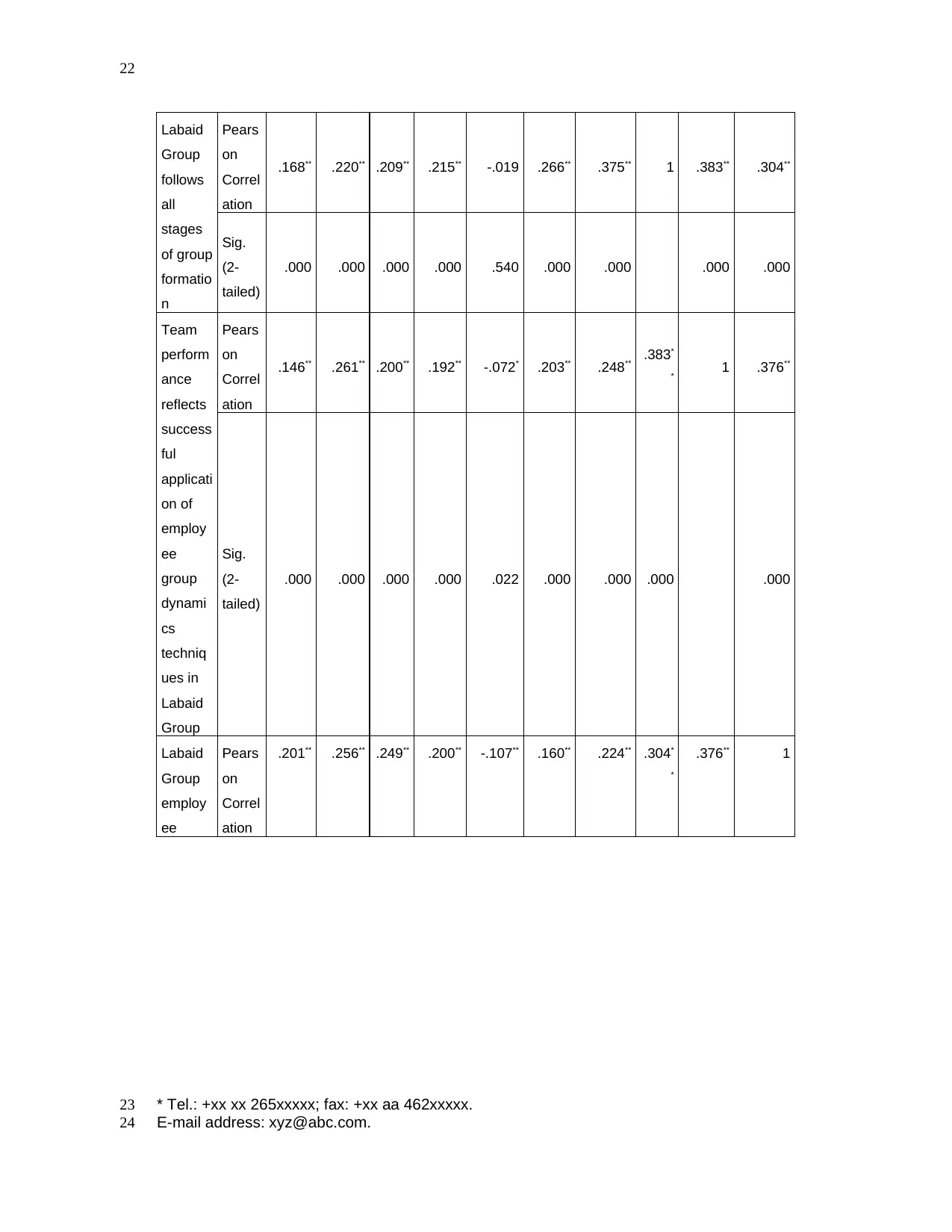
Labaid
Group
follows
all
stages
of group
formatio
n
Pears
on
Correl
ation
.168** .220** .209** .215** -.019 .266** .375** 1 .383** .304**
Sig.
(2-
tailed)
.000 .000 .000 .000 .540 .000 .000 .000 .000
Team
perform
ance
reflects
success
ful
applicati
on of
employ
ee
group
dynami
cs
techniq
ues in
Labaid
Group
Pears
on
Correl
ation
.146** .261** .200** .192** -.072* .203** .248** .383*
* 1 .376**
Sig.
(2-
tailed)
.000 .000 .000 .000 .022 .000 .000 .000 .000
Labaid
Group
employ
ee
Pears
on
Correl
ation
.201** .256** .249** .200** -.107** .160** .224** .304*
*
.376** 1
* Tel.: +xx xx 265xxxxx; fax: +xx aa 462xxxxx.
E-mail address: xyz@abc.com.
22
23
24
Group
follows
all
stages
of group
formatio
n
Pears
on
Correl
ation
.168** .220** .209** .215** -.019 .266** .375** 1 .383** .304**
Sig.
(2-
tailed)
.000 .000 .000 .000 .540 .000 .000 .000 .000
Team
perform
ance
reflects
success
ful
applicati
on of
employ
ee
group
dynami
cs
techniq
ues in
Labaid
Group
Pears
on
Correl
ation
.146** .261** .200** .192** -.072* .203** .248** .383*
* 1 .376**
Sig.
(2-
tailed)
.000 .000 .000 .000 .022 .000 .000 .000 .000
Labaid
Group
employ
ee
Pears
on
Correl
ation
.201** .256** .249** .200** -.107** .160** .224** .304*
*
.376** 1
* Tel.: +xx xx 265xxxxx; fax: +xx aa 462xxxxx.
E-mail address: xyz@abc.com.
22
23
24
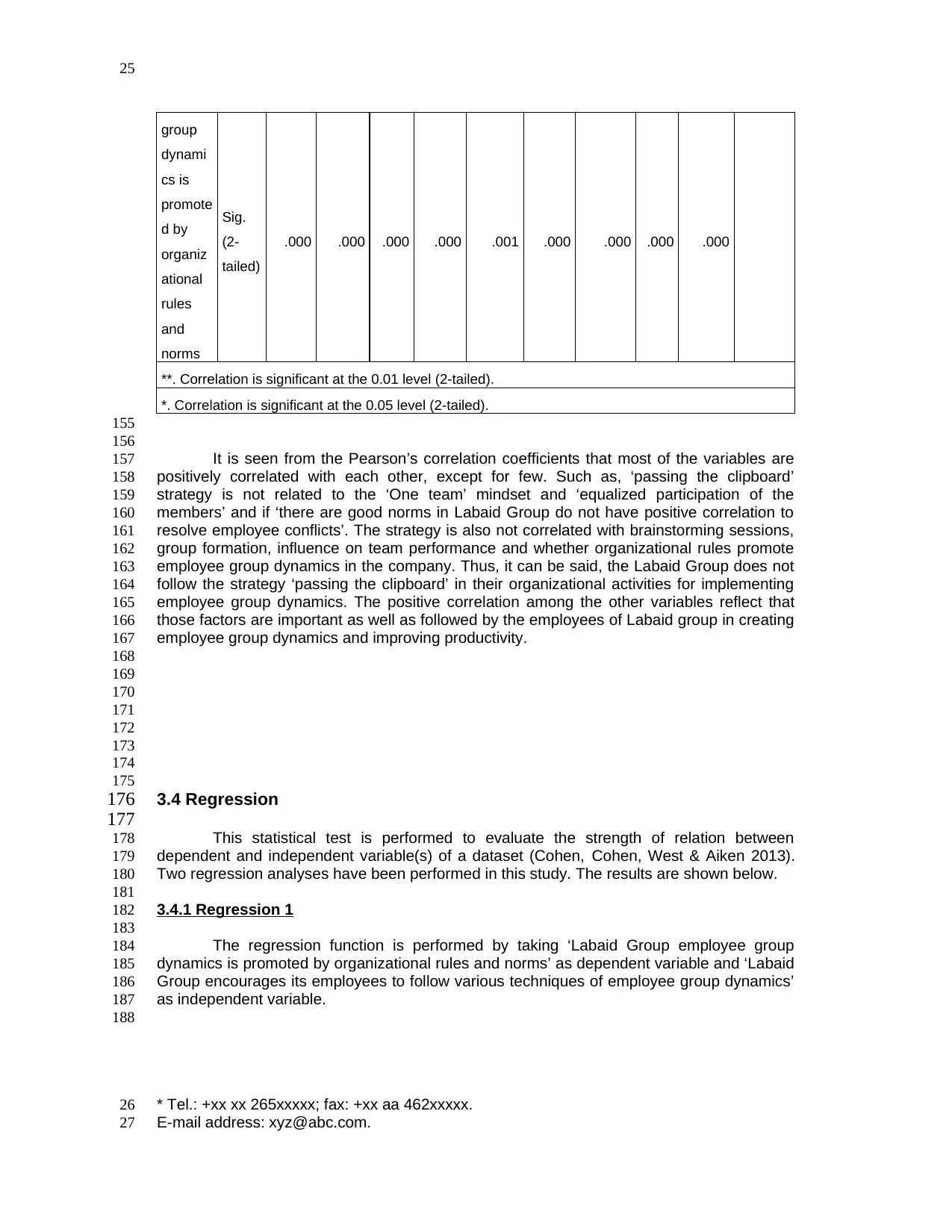
group
dynami
cs is
promote
d by
organiz
ational
rules
and
norms
Sig.
(2-
tailed)
.000 .000 .000 .000 .001 .000 .000 .000 .000
**. Correlation is significant at the 0.01 level (2-tailed).
*. Correlation is significant at the 0.05 level (2-tailed).
It is seen from the Pearson’s correlation coefficients that most of the variables are
positively correlated with each other, except for few. Such as, ‘passing the clipboard’
strategy is not related to the ‘One team’ mindset and ‘equalized participation of the
members’ and if ‘there are good norms in Labaid Group do not have positive correlation to
resolve employee conflicts’. The strategy is also not correlated with brainstorming sessions,
group formation, influence on team performance and whether organizational rules promote
employee group dynamics in the company. Thus, it can be said, the Labaid Group does not
follow the strategy ‘passing the clipboard’ in their organizational activities for implementing
employee group dynamics. The positive correlation among the other variables reflect that
those factors are important as well as followed by the employees of Labaid group in creating
employee group dynamics and improving productivity.
3.4 Regression
This statistical test is performed to evaluate the strength of relation between
dependent and independent variable(s) of a dataset (Cohen, Cohen, West & Aiken 2013).
Two regression analyses have been performed in this study. The results are shown below.
3.4.1 Regression 1
The regression function is performed by taking ‘Labaid Group employee group
dynamics is promoted by organizational rules and norms’ as dependent variable and ‘Labaid
Group encourages its employees to follow various techniques of employee group dynamics’
as independent variable.
* Tel.: +xx xx 265xxxxx; fax: +xx aa 462xxxxx.
E-mail address: xyz@abc.com.
25
155
156
157
158
159
160
161
162
163
164
165
166
167
168
169
170
171
172
173
174
175
176
177
178
179
180
181
182
183
184
185
186
187
188
26
27
dynami
cs is
promote
d by
organiz
ational
rules
and
norms
Sig.
(2-
tailed)
.000 .000 .000 .000 .001 .000 .000 .000 .000
**. Correlation is significant at the 0.01 level (2-tailed).
*. Correlation is significant at the 0.05 level (2-tailed).
It is seen from the Pearson’s correlation coefficients that most of the variables are
positively correlated with each other, except for few. Such as, ‘passing the clipboard’
strategy is not related to the ‘One team’ mindset and ‘equalized participation of the
members’ and if ‘there are good norms in Labaid Group do not have positive correlation to
resolve employee conflicts’. The strategy is also not correlated with brainstorming sessions,
group formation, influence on team performance and whether organizational rules promote
employee group dynamics in the company. Thus, it can be said, the Labaid Group does not
follow the strategy ‘passing the clipboard’ in their organizational activities for implementing
employee group dynamics. The positive correlation among the other variables reflect that
those factors are important as well as followed by the employees of Labaid group in creating
employee group dynamics and improving productivity.
3.4 Regression
This statistical test is performed to evaluate the strength of relation between
dependent and independent variable(s) of a dataset (Cohen, Cohen, West & Aiken 2013).
Two regression analyses have been performed in this study. The results are shown below.
3.4.1 Regression 1
The regression function is performed by taking ‘Labaid Group employee group
dynamics is promoted by organizational rules and norms’ as dependent variable and ‘Labaid
Group encourages its employees to follow various techniques of employee group dynamics’
as independent variable.
* Tel.: +xx xx 265xxxxx; fax: +xx aa 462xxxxx.
E-mail address: xyz@abc.com.
25
155
156
157
158
159
160
161
162
163
164
165
166
167
168
169
170
171
172
173
174
175
176
177
178
179
180
181
182
183
184
185
186
187
188
26
27
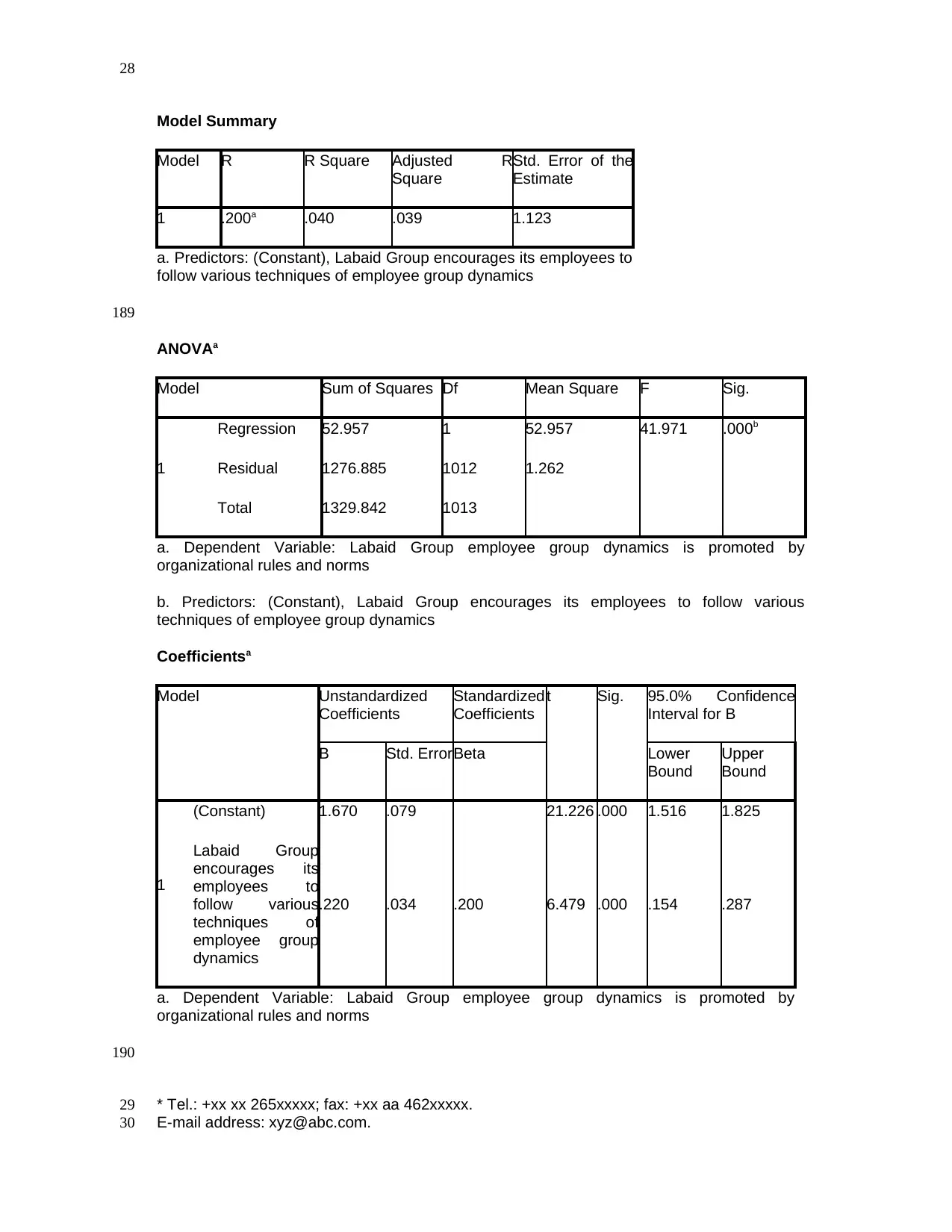
Model Summary
Model R R Square Adjusted R
Square
Std. Error of the
Estimate
1 .200a .040 .039 1.123
a. Predictors: (Constant), Labaid Group encourages its employees to
follow various techniques of employee group dynamics
ANOVAa
Model Sum of Squares Df Mean Square F Sig.
1
Regression 52.957 1 52.957 41.971 .000b
Residual 1276.885 1012 1.262
Total 1329.842 1013
a. Dependent Variable: Labaid Group employee group dynamics is promoted by
organizational rules and norms
b. Predictors: (Constant), Labaid Group encourages its employees to follow various
techniques of employee group dynamics
Coefficientsa
Model Unstandardized
Coefficients
Standardized
Coefficients
t Sig. 95.0% Confidence
Interval for B
B Std. ErrorBeta Lower
Bound
Upper
Bound
1
(Constant) 1.670 .079 21.226 .000 1.516 1.825
Labaid Group
encourages its
employees to
follow various
techniques of
employee group
dynamics
.220 .034 .200 6.479 .000 .154 .287
a. Dependent Variable: Labaid Group employee group dynamics is promoted by
organizational rules and norms
* Tel.: +xx xx 265xxxxx; fax: +xx aa 462xxxxx.
E-mail address: xyz@abc.com.
28
189
190
29
30
Model R R Square Adjusted R
Square
Std. Error of the
Estimate
1 .200a .040 .039 1.123
a. Predictors: (Constant), Labaid Group encourages its employees to
follow various techniques of employee group dynamics
ANOVAa
Model Sum of Squares Df Mean Square F Sig.
1
Regression 52.957 1 52.957 41.971 .000b
Residual 1276.885 1012 1.262
Total 1329.842 1013
a. Dependent Variable: Labaid Group employee group dynamics is promoted by
organizational rules and norms
b. Predictors: (Constant), Labaid Group encourages its employees to follow various
techniques of employee group dynamics
Coefficientsa
Model Unstandardized
Coefficients
Standardized
Coefficients
t Sig. 95.0% Confidence
Interval for B
B Std. ErrorBeta Lower
Bound
Upper
Bound
1
(Constant) 1.670 .079 21.226 .000 1.516 1.825
Labaid Group
encourages its
employees to
follow various
techniques of
employee group
dynamics
.220 .034 .200 6.479 .000 .154 .287
a. Dependent Variable: Labaid Group employee group dynamics is promoted by
organizational rules and norms
* Tel.: +xx xx 265xxxxx; fax: +xx aa 462xxxxx.
E-mail address: xyz@abc.com.
28
189
190
29
30
Secure Best Marks with AI Grader
Need help grading? Try our AI Grader for instant feedback on your assignments.
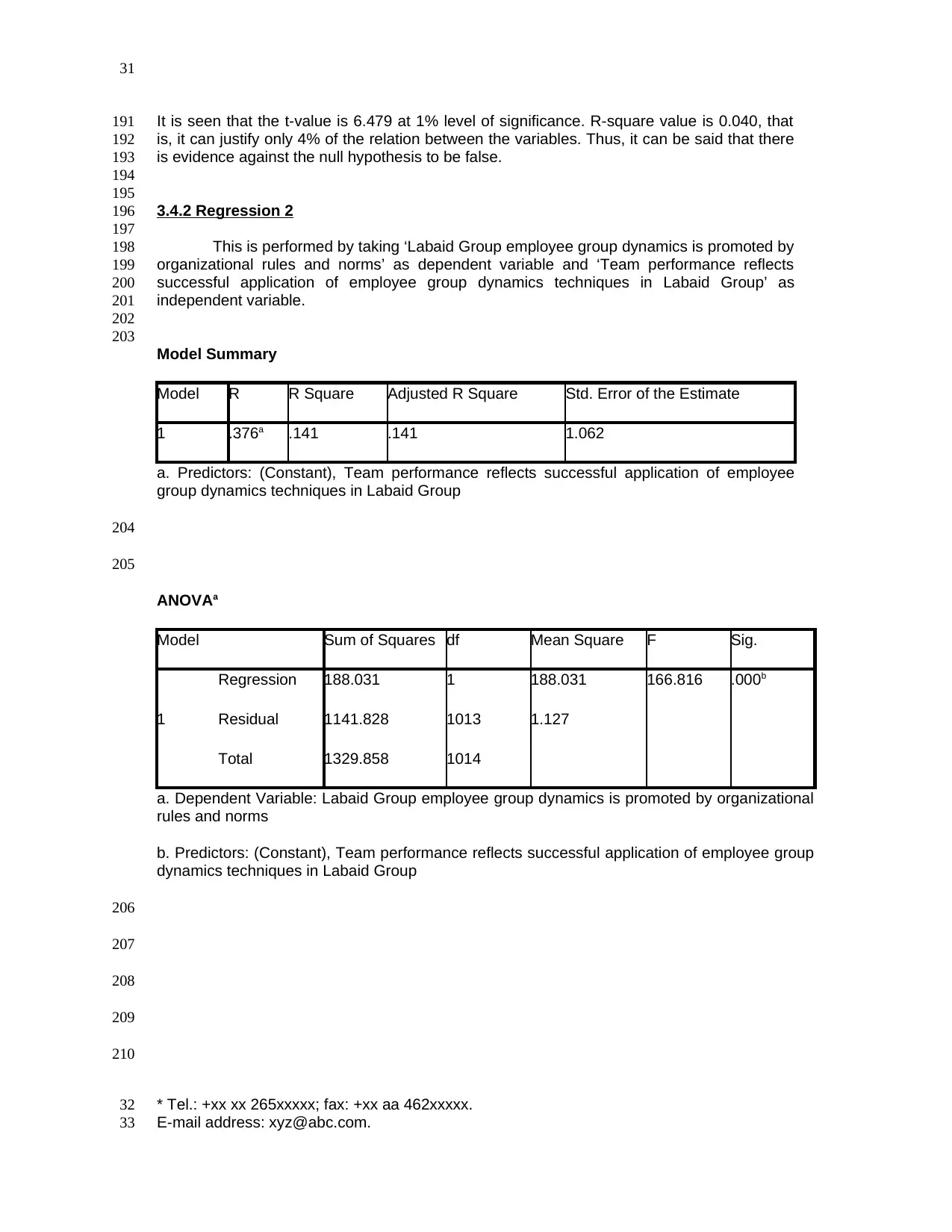
It is seen that the t-value is 6.479 at 1% level of significance. R-square value is 0.040, that
is, it can justify only 4% of the relation between the variables. Thus, it can be said that there
is evidence against the null hypothesis to be false.
3.4.2 Regression 2
This is performed by taking ‘Labaid Group employee group dynamics is promoted by
organizational rules and norms’ as dependent variable and ‘Team performance reflects
successful application of employee group dynamics techniques in Labaid Group’ as
independent variable.
Model Summary
Model R R Square Adjusted R Square Std. Error of the Estimate
1 .376a .141 .141 1.062
a. Predictors: (Constant), Team performance reflects successful application of employee
group dynamics techniques in Labaid Group
ANOVAa
Model Sum of Squares df Mean Square F Sig.
1
Regression 188.031 1 188.031 166.816 .000b
Residual 1141.828 1013 1.127
Total 1329.858 1014
a. Dependent Variable: Labaid Group employee group dynamics is promoted by organizational
rules and norms
b. Predictors: (Constant), Team performance reflects successful application of employee group
dynamics techniques in Labaid Group
* Tel.: +xx xx 265xxxxx; fax: +xx aa 462xxxxx.
E-mail address: xyz@abc.com.
31
191
192
193
194
195
196
197
198
199
200
201
202
203
204
205
206
207
208
209
210
32
33
is, it can justify only 4% of the relation between the variables. Thus, it can be said that there
is evidence against the null hypothesis to be false.
3.4.2 Regression 2
This is performed by taking ‘Labaid Group employee group dynamics is promoted by
organizational rules and norms’ as dependent variable and ‘Team performance reflects
successful application of employee group dynamics techniques in Labaid Group’ as
independent variable.
Model Summary
Model R R Square Adjusted R Square Std. Error of the Estimate
1 .376a .141 .141 1.062
a. Predictors: (Constant), Team performance reflects successful application of employee
group dynamics techniques in Labaid Group
ANOVAa
Model Sum of Squares df Mean Square F Sig.
1
Regression 188.031 1 188.031 166.816 .000b
Residual 1141.828 1013 1.127
Total 1329.858 1014
a. Dependent Variable: Labaid Group employee group dynamics is promoted by organizational
rules and norms
b. Predictors: (Constant), Team performance reflects successful application of employee group
dynamics techniques in Labaid Group
* Tel.: +xx xx 265xxxxx; fax: +xx aa 462xxxxx.
E-mail address: xyz@abc.com.
31
191
192
193
194
195
196
197
198
199
200
201
202
203
204
205
206
207
208
209
210
32
33
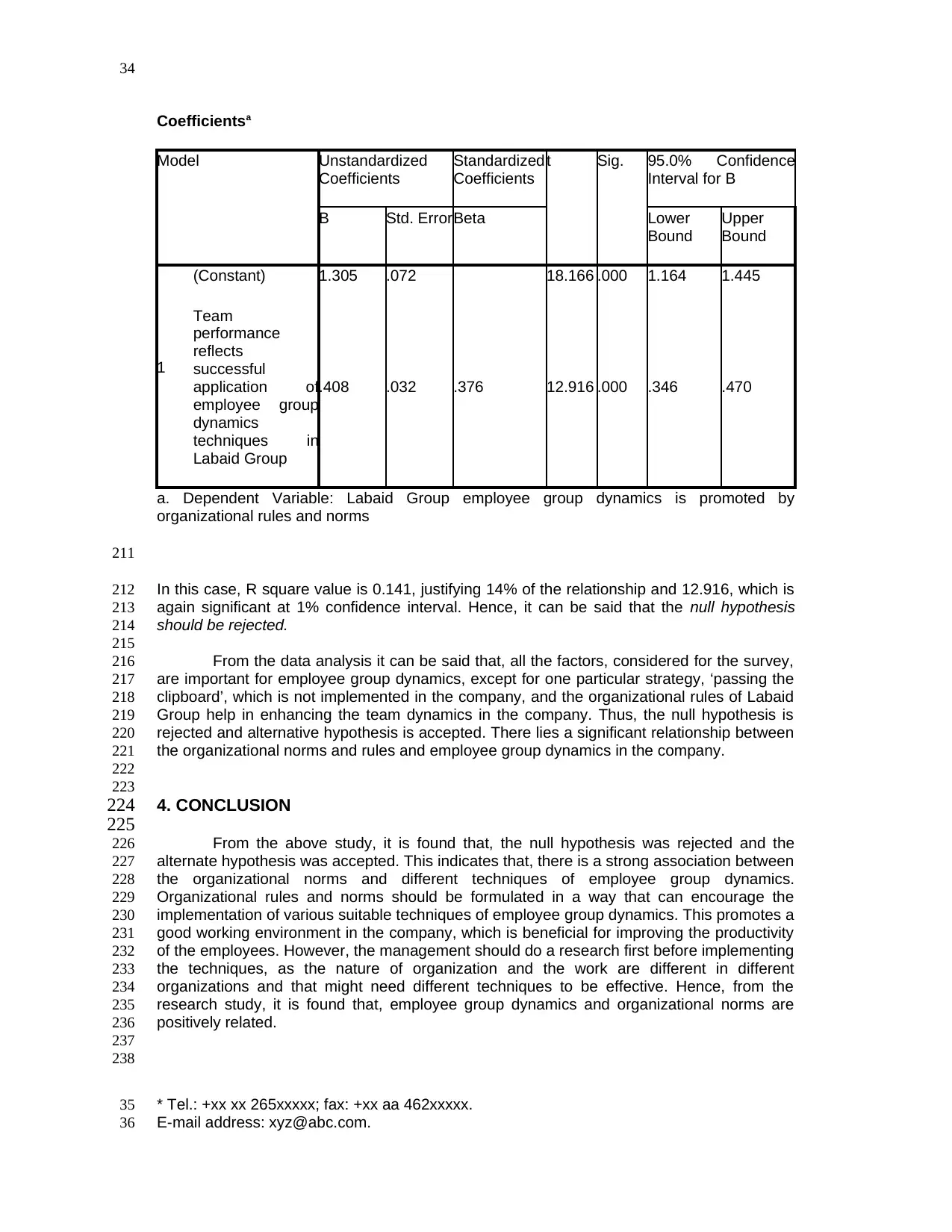
Coefficientsa
Model Unstandardized
Coefficients
Standardized
Coefficients
t Sig. 95.0% Confidence
Interval for B
B Std. ErrorBeta Lower
Bound
Upper
Bound
1
(Constant) 1.305 .072 18.166 .000 1.164 1.445
Team
performance
reflects
successful
application of
employee group
dynamics
techniques in
Labaid Group
.408 .032 .376 12.916 .000 .346 .470
a. Dependent Variable: Labaid Group employee group dynamics is promoted by
organizational rules and norms
In this case, R square value is 0.141, justifying 14% of the relationship and 12.916, which is
again significant at 1% confidence interval. Hence, it can be said that the null hypothesis
should be rejected.
From the data analysis it can be said that, all the factors, considered for the survey,
are important for employee group dynamics, except for one particular strategy, ‘passing the
clipboard’, which is not implemented in the company, and the organizational rules of Labaid
Group help in enhancing the team dynamics in the company. Thus, the null hypothesis is
rejected and alternative hypothesis is accepted. There lies a significant relationship between
the organizational norms and rules and employee group dynamics in the company.
4. CONCLUSION
From the above study, it is found that, the null hypothesis was rejected and the
alternate hypothesis was accepted. This indicates that, there is a strong association between
the organizational norms and different techniques of employee group dynamics.
Organizational rules and norms should be formulated in a way that can encourage the
implementation of various suitable techniques of employee group dynamics. This promotes a
good working environment in the company, which is beneficial for improving the productivity
of the employees. However, the management should do a research first before implementing
the techniques, as the nature of organization and the work are different in different
organizations and that might need different techniques to be effective. Hence, from the
research study, it is found that, employee group dynamics and organizational norms are
positively related.
* Tel.: +xx xx 265xxxxx; fax: +xx aa 462xxxxx.
E-mail address: xyz@abc.com.
34
211
212
213
214
215
216
217
218
219
220
221
222
223
224
225
226
227
228
229
230
231
232
233
234
235
236
237
238
35
36
Model Unstandardized
Coefficients
Standardized
Coefficients
t Sig. 95.0% Confidence
Interval for B
B Std. ErrorBeta Lower
Bound
Upper
Bound
1
(Constant) 1.305 .072 18.166 .000 1.164 1.445
Team
performance
reflects
successful
application of
employee group
dynamics
techniques in
Labaid Group
.408 .032 .376 12.916 .000 .346 .470
a. Dependent Variable: Labaid Group employee group dynamics is promoted by
organizational rules and norms
In this case, R square value is 0.141, justifying 14% of the relationship and 12.916, which is
again significant at 1% confidence interval. Hence, it can be said that the null hypothesis
should be rejected.
From the data analysis it can be said that, all the factors, considered for the survey,
are important for employee group dynamics, except for one particular strategy, ‘passing the
clipboard’, which is not implemented in the company, and the organizational rules of Labaid
Group help in enhancing the team dynamics in the company. Thus, the null hypothesis is
rejected and alternative hypothesis is accepted. There lies a significant relationship between
the organizational norms and rules and employee group dynamics in the company.
4. CONCLUSION
From the above study, it is found that, the null hypothesis was rejected and the
alternate hypothesis was accepted. This indicates that, there is a strong association between
the organizational norms and different techniques of employee group dynamics.
Organizational rules and norms should be formulated in a way that can encourage the
implementation of various suitable techniques of employee group dynamics. This promotes a
good working environment in the company, which is beneficial for improving the productivity
of the employees. However, the management should do a research first before implementing
the techniques, as the nature of organization and the work are different in different
organizations and that might need different techniques to be effective. Hence, from the
research study, it is found that, employee group dynamics and organizational norms are
positively related.
* Tel.: +xx xx 265xxxxx; fax: +xx aa 462xxxxx.
E-mail address: xyz@abc.com.
34
211
212
213
214
215
216
217
218
219
220
221
222
223
224
225
226
227
228
229
230
231
232
233
234
235
236
237
238
35
36
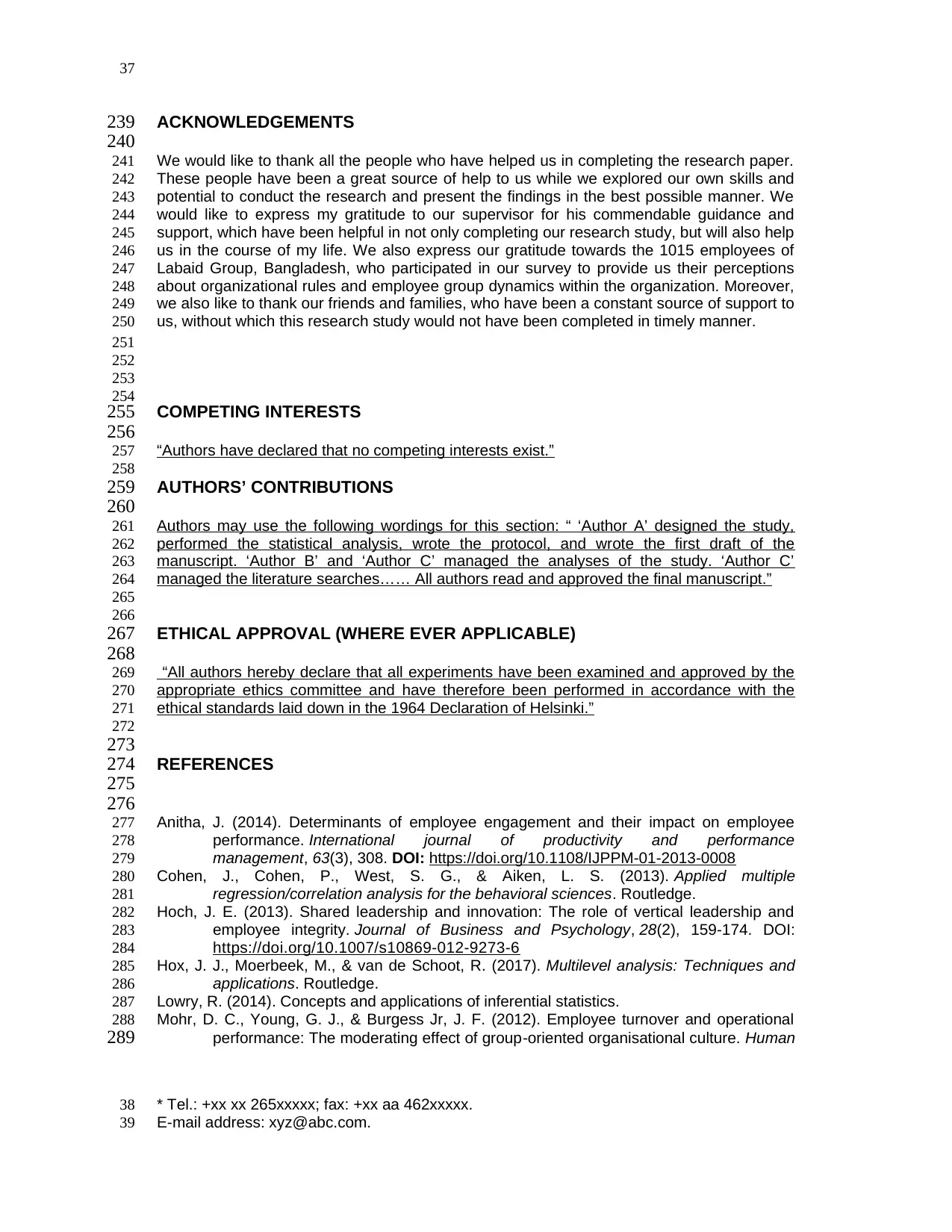
ACKNOWLEDGEMENTS
We would like to thank all the people who have helped us in completing the research paper.
These people have been a great source of help to us while we explored our own skills and
potential to conduct the research and present the findings in the best possible manner. We
would like to express my gratitude to our supervisor for his commendable guidance and
support, which have been helpful in not only completing our research study, but will also help
us in the course of my life. We also express our gratitude towards the 1015 employees of
Labaid Group, Bangladesh, who participated in our survey to provide us their perceptions
about organizational rules and employee group dynamics within the organization. Moreover,
we also like to thank our friends and families, who have been a constant source of support to
us, without which this research study would not have been completed in timely manner.
COMPETING INTERESTS
“Authors have declared that no competing interests exist.”
AUTHORS’ CONTRIBUTIONS
Authors may use the following wordings for this section: “ ‘Author A’ designed the study,
performed the statistical analysis, wrote the protocol, and wrote the first draft of the
manuscript. ‘Author B’ and ‘Author C’ managed the analyses of the study. ‘Author C’
managed the literature searches…… All authors read and approved the final manuscript.”
ETHICAL APPROVAL (WHERE EVER APPLICABLE)
“All authors hereby declare that all experiments have been examined and approved by the
appropriate ethics committee and have therefore been performed in accordance with the
ethical standards laid down in the 1964 Declaration of Helsinki.”
REFERENCES
Anitha, J. (2014). Determinants of employee engagement and their impact on employee
performance. International journal of productivity and performance
management, 63(3), 308. DOI: https://doi.org/10.1108/IJPPM-01-2013-0008
Cohen, J., Cohen, P., West, S. G., & Aiken, L. S. (2013). Applied multiple
regression/correlation analysis for the behavioral sciences. Routledge.
Hoch, J. E. (2013). Shared leadership and innovation: The role of vertical leadership and
employee integrity. Journal of Business and Psychology, 28(2), 159-174. DOI:
https://doi.org/10.1007/s10869-012-9273-6
Hox, J. J., Moerbeek, M., & van de Schoot, R. (2017). Multilevel analysis: Techniques and
applications. Routledge.
Lowry, R. (2014). Concepts and applications of inferential statistics.
Mohr, D. C., Young, G. J., & Burgess Jr, J. F. (2012). Employee turnover and operational
performance: The moderating effect of group‐oriented organisational culture. Human
* Tel.: +xx xx 265xxxxx; fax: +xx aa 462xxxxx.
E-mail address: xyz@abc.com.
37
239
240
241
242
243
244
245
246
247
248
249
250
251
252
253
254
255
256
257
258
259
260
261
262
263
264
265
266
267
268
269
270
271
272
273
274
275
276
277
278
279
280
281
282
283
284
285
286
287
288
289
38
39
We would like to thank all the people who have helped us in completing the research paper.
These people have been a great source of help to us while we explored our own skills and
potential to conduct the research and present the findings in the best possible manner. We
would like to express my gratitude to our supervisor for his commendable guidance and
support, which have been helpful in not only completing our research study, but will also help
us in the course of my life. We also express our gratitude towards the 1015 employees of
Labaid Group, Bangladesh, who participated in our survey to provide us their perceptions
about organizational rules and employee group dynamics within the organization. Moreover,
we also like to thank our friends and families, who have been a constant source of support to
us, without which this research study would not have been completed in timely manner.
COMPETING INTERESTS
“Authors have declared that no competing interests exist.”
AUTHORS’ CONTRIBUTIONS
Authors may use the following wordings for this section: “ ‘Author A’ designed the study,
performed the statistical analysis, wrote the protocol, and wrote the first draft of the
manuscript. ‘Author B’ and ‘Author C’ managed the analyses of the study. ‘Author C’
managed the literature searches…… All authors read and approved the final manuscript.”
ETHICAL APPROVAL (WHERE EVER APPLICABLE)
“All authors hereby declare that all experiments have been examined and approved by the
appropriate ethics committee and have therefore been performed in accordance with the
ethical standards laid down in the 1964 Declaration of Helsinki.”
REFERENCES
Anitha, J. (2014). Determinants of employee engagement and their impact on employee
performance. International journal of productivity and performance
management, 63(3), 308. DOI: https://doi.org/10.1108/IJPPM-01-2013-0008
Cohen, J., Cohen, P., West, S. G., & Aiken, L. S. (2013). Applied multiple
regression/correlation analysis for the behavioral sciences. Routledge.
Hoch, J. E. (2013). Shared leadership and innovation: The role of vertical leadership and
employee integrity. Journal of Business and Psychology, 28(2), 159-174. DOI:
https://doi.org/10.1007/s10869-012-9273-6
Hox, J. J., Moerbeek, M., & van de Schoot, R. (2017). Multilevel analysis: Techniques and
applications. Routledge.
Lowry, R. (2014). Concepts and applications of inferential statistics.
Mohr, D. C., Young, G. J., & Burgess Jr, J. F. (2012). Employee turnover and operational
performance: The moderating effect of group‐oriented organisational culture. Human
* Tel.: +xx xx 265xxxxx; fax: +xx aa 462xxxxx.
E-mail address: xyz@abc.com.
37
239
240
241
242
243
244
245
246
247
248
249
250
251
252
253
254
255
256
257
258
259
260
261
262
263
264
265
266
267
268
269
270
271
272
273
274
275
276
277
278
279
280
281
282
283
284
285
286
287
288
289
38
39
Paraphrase This Document
Need a fresh take? Get an instant paraphrase of this document with our AI Paraphraser
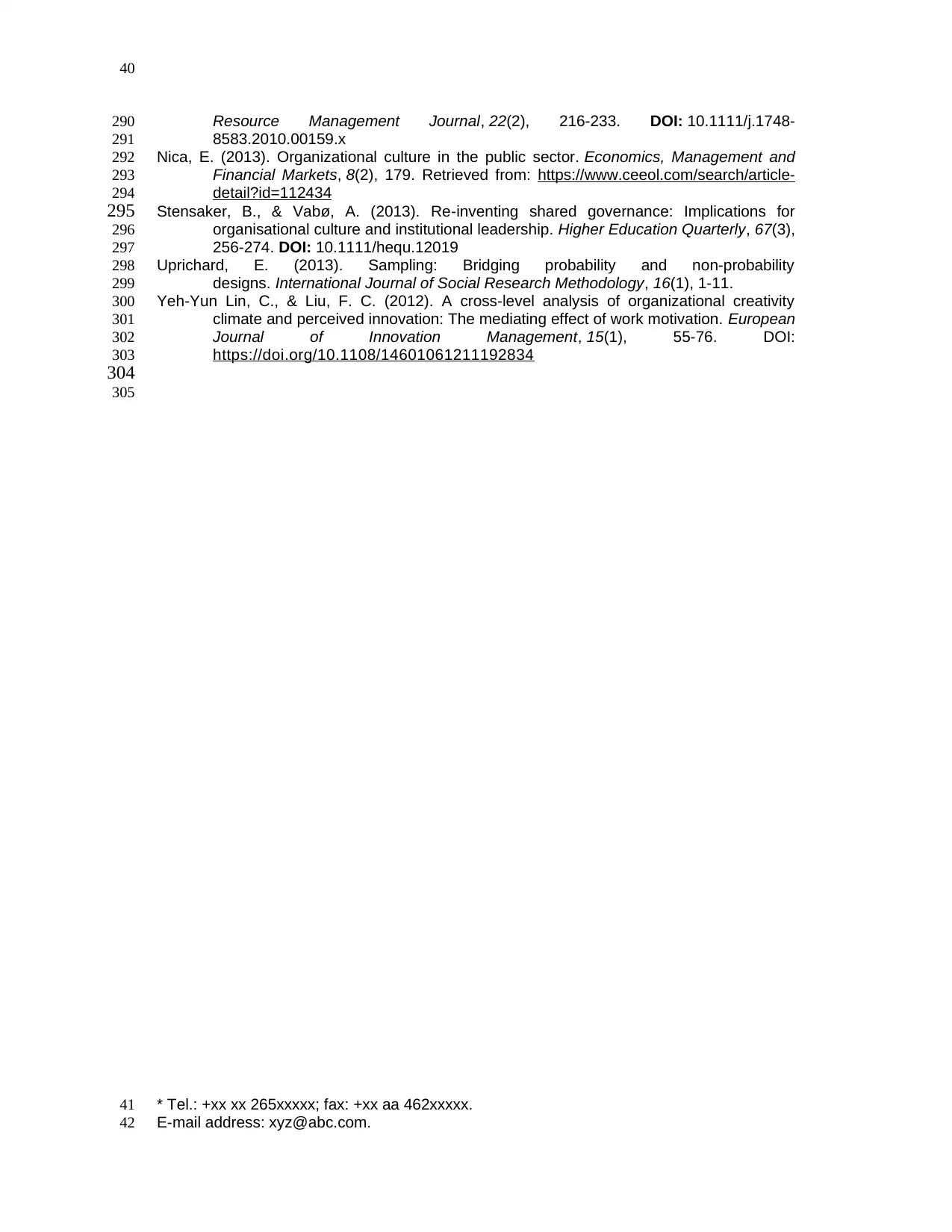
Resource Management Journal, 22(2), 216-233. DOI: 10.1111/j.1748-
8583.2010.00159.x
Nica, E. (2013). Organizational culture in the public sector. Economics, Management and
Financial Markets, 8(2), 179. Retrieved from: https://www.ceeol.com/search/article-
detail?id=112434
Stensaker, B., & Vabø, A. (2013). Re‐inventing shared governance: Implications for
organisational culture and institutional leadership. Higher Education Quarterly, 67(3),
256-274. DOI: 10.1111/hequ.12019
Uprichard, E. (2013). Sampling: Bridging probability and non-probability
designs. International Journal of Social Research Methodology, 16(1), 1-11.
Yeh-Yun Lin, C., & Liu, F. C. (2012). A cross-level analysis of organizational creativity
climate and perceived innovation: The mediating effect of work motivation. European
Journal of Innovation Management, 15(1), 55-76. DOI:
https://doi.org/10.1108/14601061211192834
* Tel.: +xx xx 265xxxxx; fax: +xx aa 462xxxxx.
E-mail address: xyz@abc.com.
40
290
291
292
293
294
295
296
297
298
299
300
301
302
303
304
305
41
42
8583.2010.00159.x
Nica, E. (2013). Organizational culture in the public sector. Economics, Management and
Financial Markets, 8(2), 179. Retrieved from: https://www.ceeol.com/search/article-
detail?id=112434
Stensaker, B., & Vabø, A. (2013). Re‐inventing shared governance: Implications for
organisational culture and institutional leadership. Higher Education Quarterly, 67(3),
256-274. DOI: 10.1111/hequ.12019
Uprichard, E. (2013). Sampling: Bridging probability and non-probability
designs. International Journal of Social Research Methodology, 16(1), 1-11.
Yeh-Yun Lin, C., & Liu, F. C. (2012). A cross-level analysis of organizational creativity
climate and perceived innovation: The mediating effect of work motivation. European
Journal of Innovation Management, 15(1), 55-76. DOI:
https://doi.org/10.1108/14601061211192834
* Tel.: +xx xx 265xxxxx; fax: +xx aa 462xxxxx.
E-mail address: xyz@abc.com.
40
290
291
292
293
294
295
296
297
298
299
300
301
302
303
304
305
41
42
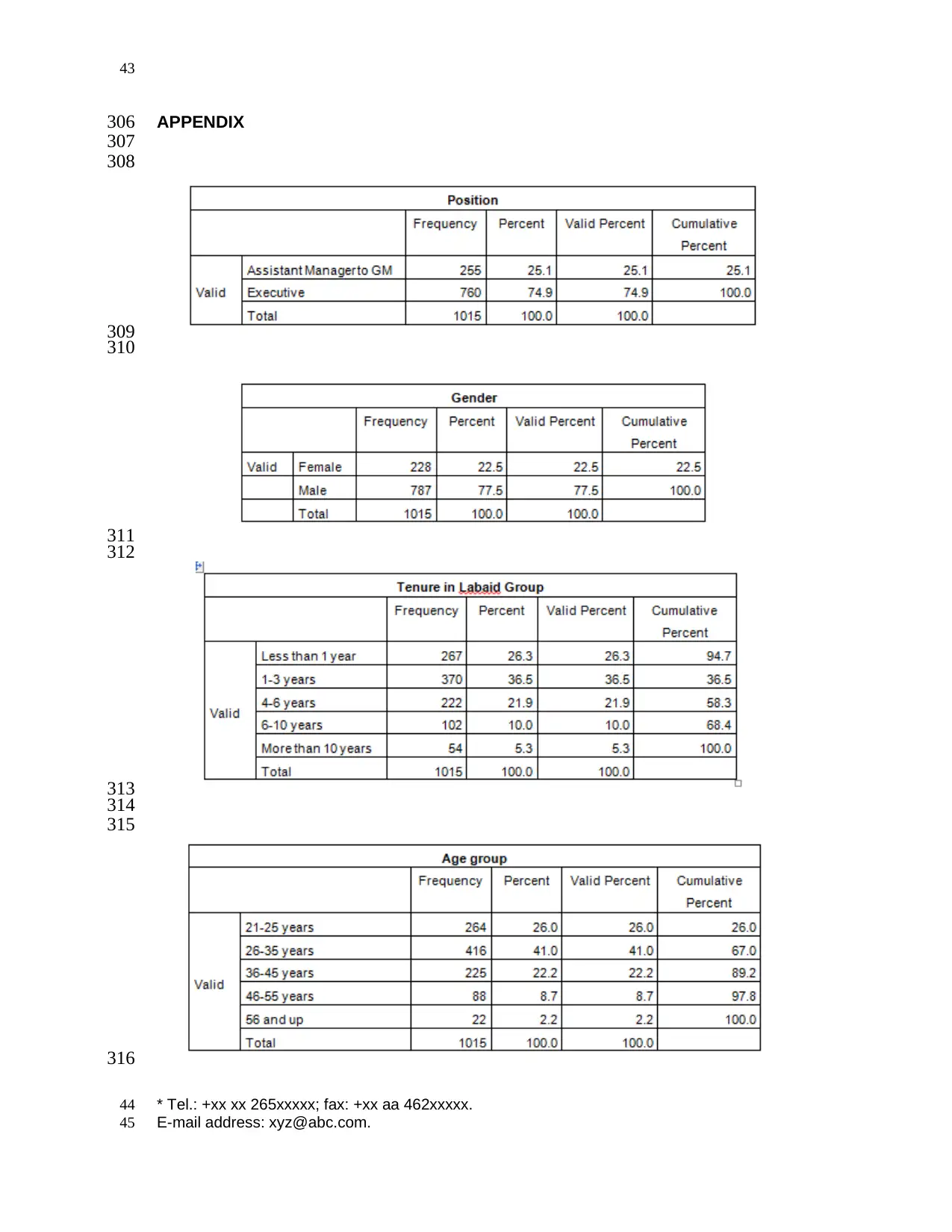
APPENDIX
* Tel.: +xx xx 265xxxxx; fax: +xx aa 462xxxxx.
E-mail address: xyz@abc.com.
43
306
307
308
309
310
311
312
313
314
315
316
44
45
* Tel.: +xx xx 265xxxxx; fax: +xx aa 462xxxxx.
E-mail address: xyz@abc.com.
43
306
307
308
309
310
311
312
313
314
315
316
44
45
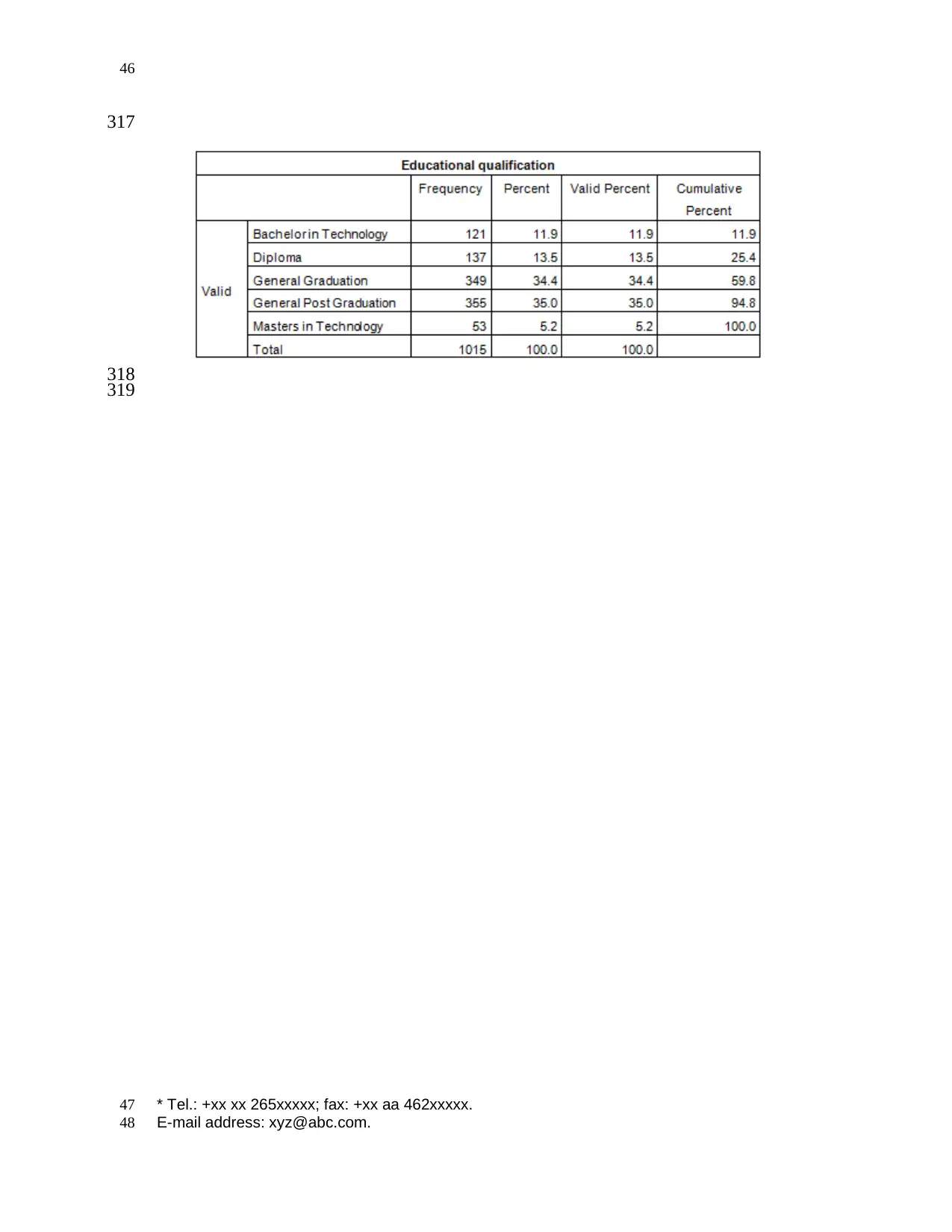
* Tel.: +xx xx 265xxxxx; fax: +xx aa 462xxxxx.
E-mail address: xyz@abc.com.
46
317
318
319
47
48
E-mail address: xyz@abc.com.
46
317
318
319
47
48
Secure Best Marks with AI Grader
Need help grading? Try our AI Grader for instant feedback on your assignments.

49
320
50
320
50
1 out of 17
Related Documents
Your All-in-One AI-Powered Toolkit for Academic Success.
+13062052269
info@desklib.com
Available 24*7 on WhatsApp / Email
![[object Object]](/_next/static/media/star-bottom.7253800d.svg)
Unlock your academic potential
© 2024 | Zucol Services PVT LTD | All rights reserved.




